

| This area is for the ROLLER COASTER enthusiast, as I am one myself! On this page you will find some pictures of roller coasters and many other extreme rides. Some of the largest, longest, and highest record-breaking roller coasters appear on this page! See some extreme rides, such as the "Ejection Seat" and "Sling Shot"! See interesting "drop / free-fall" rides, where you fall 300 feet and are slowed in less than a second by magnetic brakes! This page also includes many fair-rides and even bungee jumping. See my list of all the roller-coasters that I have ridden in my life, in the "roller-coaster resume" section. Got homework? Check out the informative physics section about G FORCE and its effects later in this page ... Fantastic for teachers and science students! Note - This page may take a while to load on some SLOWER connections! |

They do post these signs for a reason ... If you are not fit or capeable of riding, or not sure about this, then it is suggested you do not take any chances. Thrill rides are fun, but people with a fear of heights, or even worse, physical limitations (back problems, heart problems, diabetes, epilepsy, etc) should refrain from subjecting themselves to the intense forces and / or thrills experienced on such attractions. Unfortunately, there has been fatalities associated with people with health problems (some who did not even know they had) that were aggravated by a thrill ride. The main danger is the extremely high forces caused by changes in direction (such as in high speed turns) or changes in attitude (position - such as rolls and going upside down). Such forces, known as G-FORCE, can be both exhilerating but dangerous as well. If you do not understand what G-FORCE is (and the effects of G-FORCE), then I strongly recommend that you read my section on G-FORCE at the end of this page (you can see it by clicking HERE). Now with this unpleasant note out of the way, go ahead and enjoy what this page has to offer!
 Extreme Activities Mix 360 VR Music Video (4k)
Extreme Activities Mix 360 VR Music Video (4k) Six Flags In Gurnee IL 2015 Coasters Compilation With Music
Six Flags In Gurnee IL 2015 Coasters Compilation With Music Leviathan Coaster (Canada's Wonderland) In June 2013
Leviathan Coaster (Canada's Wonderland) In June 2013 Six Flags Theme Parks Compilation
Six Flags Theme Parks Compilation Summer 07-09 Theme Parks Music Video II
Summer 07-09 Theme Parks Music Video II Top Thrill Dragster Ride
Top Thrill Dragster Ride Mantis & Millenium Force Roller Coasters
Mantis & Millenium Force Roller Coasters Delirium & Drop Zone
Delirium & Drop Zone Racer & Beast Wooden Roller Coasters
Racer & Beast Wooden Roller Coasters Face-Off Roller Coaster
Face-Off Roller Coaster Vortex Roller Coaster
Vortex Roller Coaster Ejection Seat & Slingshot
Ejection Seat & Slingshot Extreme Rides At The Fair
Extreme Rides At The Fair
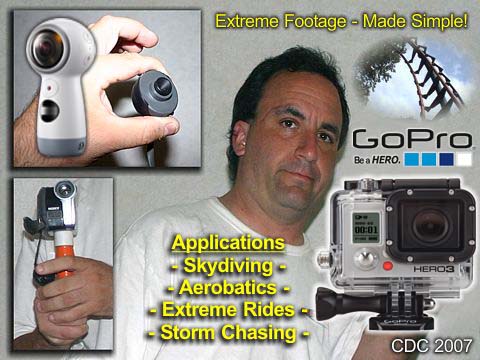
You will see many shots of thrill rides and roller coasters on this web page, many of them from ON-RIDE footage! You probably wonder how can you take pictures while riding a roller coaster? The answer to that is two things. First - Technology, as cameras are smaller and digital nowadays. Second - The ability to BE ABLE TO film and concentrate on shots while flipping upside down, enduring crushing G-Forces, and being slammed all over the place like beans inside a rattler! In the diagram above, the camcorder I am holding (lower left inset) is a Sony DCR-HC28, and it's a small digital mini-DV camcorder that is small and lightweight, and most of all, is really cheap - So if it gets lost or broken, no big deal (but I want the tape back)! Holding this camera is not easy, so I built the "monopod" for it (screws into the standard tripod mount on the camera's underside). Originally designed for storm / hurricane chasing, so winds don't rip the camera from my hands, the monopod also works fantastic for filming on-ride footage of coasters and other extreme rides. The inset to the lower-left shows how easy-to-use the monopod grip is. To the upper left is an external "button" camera used on some projects, along with a newer 360 VR camera from Samsung. The small camera is lightly larger than a quarter, and powered by a 9V battery, this little camera can be mounted anywhere - On a helmet, outside a vehicle, or clipped (or taped) onto something. It outputs NTSC video and sound and feeds into the auxiliary inputs to any video recorder, such as the small camcorder in my pocket! This setup is very concealed - Great for skydiving, and especially great for roller coasters / thrill rides. In the same inset is a newer 360 camera from Samsung, which can also be hand-held on the same monopod, and shoots immersive 4k spherical video. Ofcourse, to the right, is the newer and ultimately successful GoPro HD / 4k camera used for many extreme sports or activities. Unfortunately, theme park officials are cracking down on the use of these cameras on extreme rides, even with proper mounting due to liability. Six Flags has actually banned "selfie" sticks from most of their parks!
Action Park was a thrill-seeking theme park that operated near Vernon / Sussex, New Jersey from around 1980 until it was forced to shut down in late 1996. When I was young, it was a MUST for me and my friends (I still remember the jingle: "The 'action never stops' at Action Park"!) during the hot New England summers, never thinking about how dangerous this place really was. Most of the rides were poorly designed, on par with a rigged up back-yard swing or rickety go-kart, only larger - and higher! The name of this park became notorious, after injuries, and even deaths, began occurring in the early to mid 80's. The names 'Accident Park' and 'Traction Park' became common jokes from those working the nearby hospital. There was a "wet" (water slides and pools) and "dry" ride type, with the latter being Go Karts, boats, bungee jumping, and thrill rides. Many of these rides were also poorly maintained, and some even modified to bypass safety systems such speed limiters (for example, one ride was modified to go faster by jamming tennis balls in one of the controls)! Another fatality occurred with the Kayak Experience ride, where the victim was electrocuted as he contacted a live wire after his kayak overturned near an aerating fan. Alas, after lawsuits and more injuries, the park closes for good in 1996. After that, many of the attractions were removed, and the park operated under "Mountain Creek". Below are some pictures I took during Action Parks final days.
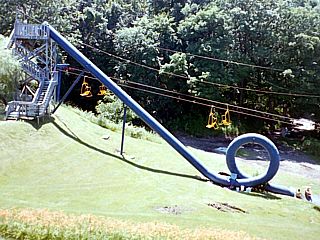
|
Greeting the first visitors near the entrance of the park was this ominous sight - An enclosed water slide with a vertical loop! This was the only such slide in the world to feature this maneuver. I have not personally ridden this, as it was never open to the public (only for a short time). Looking like fun, this was a potential death trap (note the "hatch" installed at the bottom of the slide just before the loop). Park employees were actually paid $100 to try this back in the 80's! A test dummy sent down the slide came out the other end missing its head. Those (un)lucky enough to try this ride (during it's very brief operation) often suffered back / neck injuries - The loop is circular, not the "clothoid" (tear-drop shape) we see on roller coasters - So anyone hitting the start of the loop would incur G-forces that could cause whiplash and even spinal injuries. It remained shut-down for many years, but silently stood here at the park entrance until it closed; reminding many that Action Park meant business when it came to risks. |
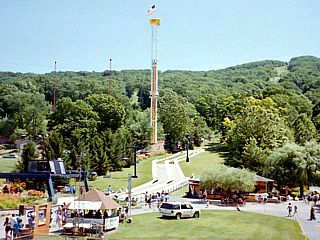
|
Here is a view of the bottom of the Alpine Slide (note the chairlift and ski-hills as well). This was basically a concrete chute in which you rode down on in a "kart" or sled-type vehicle. Frequently, the karts would jump off the track, causing nasty abrasive type injuries (especially given the fact that most riders, who would ride the slide right after a water ride, would be in bathing suits and shirtless)! The ride up on the chairlift also paralleled the slide route, and often there was spitting and name calling from rowdy teens in the lift. The ride down itself was also a challenge - The karts had a brake that either worked (screeching the kart to a stop) or completely disengaged (causing absolutely NO speed control, or as one park employee put it "death awaits"). At least one person thrown from the Alpine Slide was killed after his head hit a rock. The tower in the sky is the Space Shot ride, a much safer S&S Power air-launch ride. |
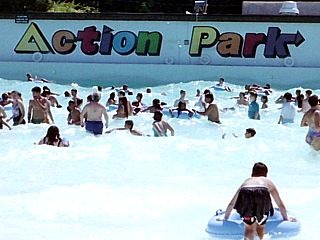
|
This is the wave pool at Action Park, pretty much as it was in the mid to late 1980's. This was another notorious attraction that would claim at least 3 young people, earning the slang name "the grave pool". The pool uses pneumatic action to generate resonant waves for 10-20 minute cycles with heights up to 3 feet. The problems were the depth of the water in the deep end as well as a "notch" in the sides where people can get stuck temporarily as a wave passed. Mountain Creek continued to operate this attraction but with special changes with safety in mind. |
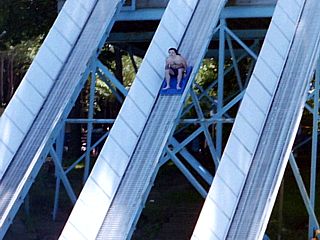
|
This is a picture of me going down the "Aqua Scoot" attraction. It's nothing more that a blue plastic "sled" that you carry to the top, and slide down on rollers (like a conveyor at a warehouse). Upon reaching the bottom, hopefully you will have enough speed to skip across the water like a stone (as shown below). |
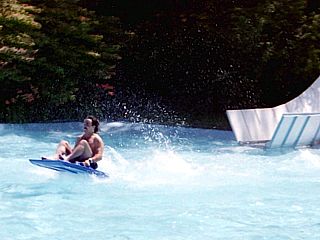
|
This is the same "Aqua Scoot" attraction with me in the sled skipping across the water like a stone. This ride also had it's share of incidents ... Some folks would simply "wipe out" in the sled upon contact with the water, hitting their head on the concrete floor of the pool, which was less than 2 feet deep. Less likely, anyone coming off the sled on the descent could be susceptible to a nasty pinch injury from the rollers. |
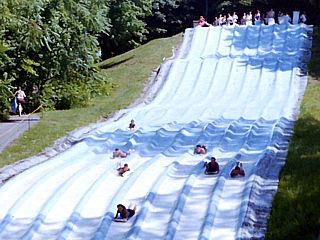
|
Here is an interesting attraction that was a popular one at Action Park. This was called "Surf Hill" (or the "Mountain Coaster Surfing Hill"). Basically it is a hillside (side of the mountain) covered with padded material, onto which water is sprayed. You are given a "mat" to slide on. Collisions and "lane jumps" were common, along with laughs at the snack bar at the base of the hill (where this picture was taken) as an occasional lost bakini or wipeout would make the experience more humorous. |
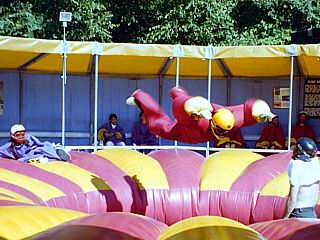
|
This was one of the more interesting "dry rides" called the "Aerodium". It was an up-charge attraction (I believe $5 in addition to the entrance fee at the time) where you can "skydive" on an air column driven by a 650 HP fan turned by a diesel engine. This is basically a first-generation vertical wind runnel (VWT) with an updraft speed of about 90 MPH. For more information on vertical wind tunnels, please see my SKYDIVING section on this web site for a more in-depth explanation on how they work. |
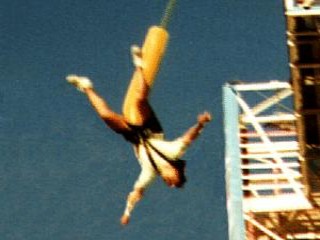
|
Finally, here is me Bungee jumping from a 120 foot tower at Action Park in 1996. I am doing a backwards "Nestea Plunge". |
County (traveling) fairs often bring thrills and excitement for a short time period to many counties and cities all over the United States. There are large traveling fairs, such as the "Dade County Youth Fair" in Miami-Dade County, Florida that can last for 2-3 weeks, as well as much smaller fairs which only last a few days. Going to the fair can be a fun experience for friends as well as the entire family regardless of age. May fairs have a large so called "Midway", with games, shows, and rides of all types, including roller coasters. The fairs may also have an exposition of livestock (aka: a small "zoo"), a circus, and shops. After the fair, everything is packed up, folded away, put on trucks, and the entire operation is on the road - literally! Many big names in traveling fairs include Conklin Shows and United Shows.
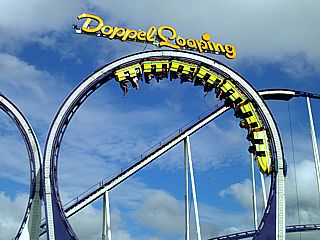
|
The "Doppel Looping" roller coaster is a major hit and attraction at the 2008 Dade County Youth Fair, as it was for many years prior. The coaster features two loops and a few "high-G" turns. In this picture, the coaster is inverted (upside-down) in one of the coasters loops. |
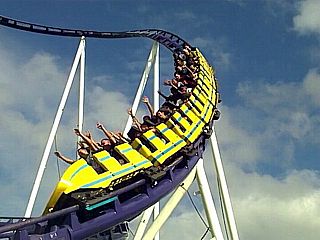
|
Here is a picture of the main "drop" on the "Doppel Looping" roller coaster at the 2008 Dade County Youth Fair. |
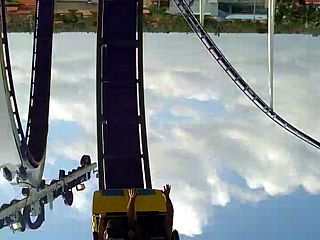
|
This is a picture taken during the second loop of the "Doppel Looping" coaster at the 2008 Dade County Youth Fair. |
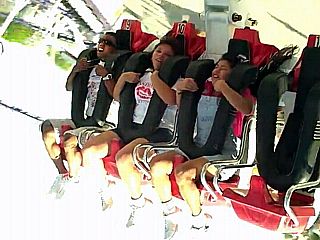
|
This is a picture off the ride "Spinout" at the 2008 Dade County Youth Fair. This is a large wheel which spins and inverts its passengers. In this picture, the occupants are upside-down. |
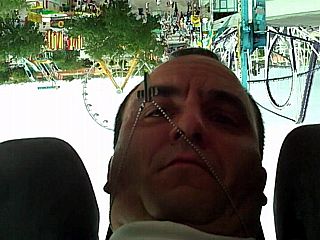
|
Here is a picture of myself in an inverted attitude (upside down) on the "Invertor" ride at the 2008 dade County Youth Fair. Note the effects of negative G-Forces (Hint: My necklace)! |
Six Flags is the world's largest chain of theme parks throughout the United States and some other countries (such as Canada and Mexico). Six Flags originally began in Texas, as you will see many pictures in this section from this first them park - Six Flags over Texas between Dallas and Fort Worth (Arlington). I have also been to several other Six Flags theme parks, such as Six Flags Great Adventure in Jackson, New Jersey and Six Flags Great American in Gurnee Illinois. The Six Flags chain thrills more than 9 million guests per quarter during its most busy operating season.
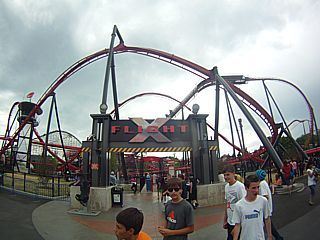
|
This is a picture of the entrance to the X-Flight roller coaster at Six Flags in Gurnee, Illinois. This roller coaster is of a "wing" design (where two people sit on each side of a car instead of in it), and was completed in mid May 2012. |
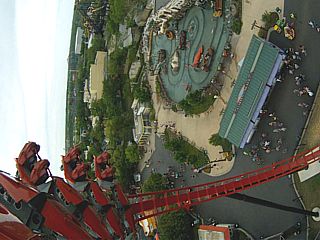
|
This is a picture (taken from GoPro video) of the "dive loop" drop after the lift hill on the X-Flight roller coaster at Six Flags in Gurnee, Illinois. The 3,000 foot track features five inversions (with one barrel roll THROUGH a key-hole in a control-tower structure) and speeds up to 55 MPH. |
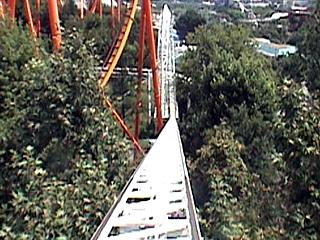
|
This is a picture (taken from video) of the approach to the first (and only) inversion on the "Revolution" coaster at Six Flags Magic Mountain in Valencia, California. Recognize the shot? If so, you probably seen it in several movies, including "Vacation" back in 1983! |
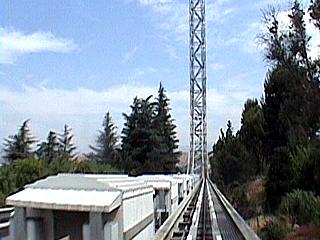
|
This is a picture (taken from video) of the "acceleration track" of the Superman "The Escape' ride at Six Flags Magic Mountain in Valencia, California. This impressive ride features an acceleration to 100-MPH in about 7-seconds followed by an ascent up a 400-foot tower (and subsequent fall-back along the same route). This was the first coaster to reach 100-MPH, thanks to linear induction motors (LIMs). |
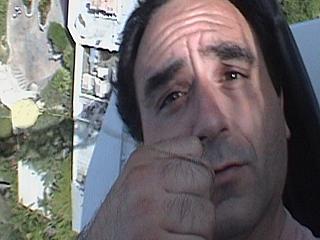
|
At the top of the tower of the Superman "Escape" ride at Six Flags Magic Mountain in Valencia, California, a period of weightlessness (0 G "free-fall") is experienced. In this picure, taken from a video frame-grab, you see me, 400 feet in the air, with my "Saint Christopher" medallion "floating" in the air (look closely to the left). This period of weightlessness, lasts for about 6 seconds on this ride, after a "squinting" 5 G pullup (and subsequent fall-back) at nearly 100-MPH. |
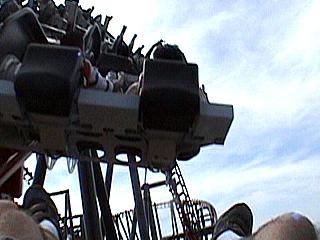
|
This is a picture (taken from video) of the "X" coaster at Six Flags Magic Mountain in Valencia, California. Not only does this incredible roller coaster drop ver 170 feet and take you through turns and all that, but it's seats pitch a full axis thanks to a "4-th track" that controls this "new dimension" of freedom. Confused? Try it! |
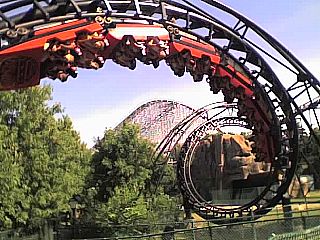
|
This is a picture of the corkscrew section of the Demon coaster at Six Flags in Gurnee, Illinois. The Demon is a 50-MPH coaster with a 102 foot lift hill, 4 inversions, and 2,130 feet of steel track. The corkscrew "barrel" roll seen here is the finale of the ride. |
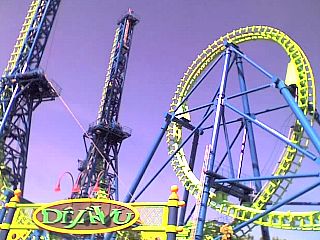
|
Deja-Vu is a shuttle type steel roller coaster at Six Flags in Gurnee, Illinois. The track has the typical Vekoma design. The lift on this ride is a catch-car assembly that hoists the train up a first tower via cable, releases it, then the train rolls through its coarse. At the far end, another hoist lifts the train again, and releases it, and it rolls back through the coarse the opposite way and back to the station. The first catch car / cable slows the train at the end of its run. |
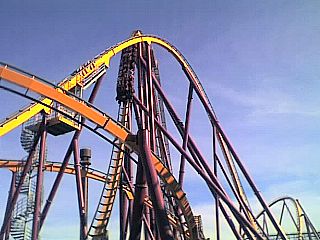
|
The Raging Bull is another steel roller coaster at Six Flags in Gurnee, Illinois. There is much airtime on this ride, especially in the nearly "parabolic" hill seen in this picture! The coaster has a 208 foot first drop at 65-degrees and reaches speeds of 73-MPH. In this picture, the train is in the first drop. |
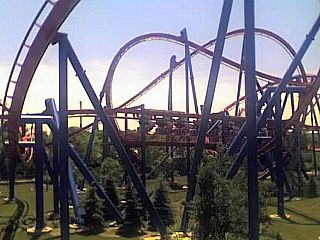
|
Here is a view of a section of the Superman Ultimate Flight steel roller coaster at Six Flags in Gurnee, Illinois. This coaster is unique as you ride lying on your stomach facing forward, just as if you were "flying like superman". In this picture, the most notable feature is the "pretzel loop", where the coarse forms a "heart" shape with overlapping tracks at the top forming the "pretzel". Riders enter the pretzel loop facing the earth, but round the bottom of the loop on their backs in a high-G "eyeballs in" condition, then come out the top facing the earth again. |
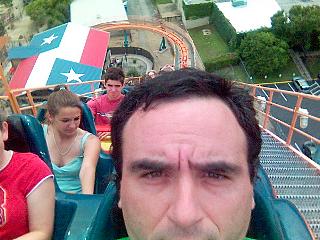
|
Here is a picture of myself, taken with a cellular-phone camera, while going up the chain drive lift (I am about half-way up the 265 foot lift in this picture) of "Titan", an 85-MPH hypercoaster at Six Flags over Texas near Dallas. |
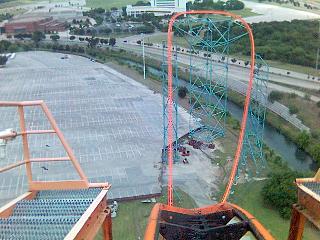
|
This is another picture taken from the top of the first drop, of 265 feet, on the hyper roller-coaster "Titan" at Six Flags over Texas near Dallas. This picture was taken with a cellular-phone camera, at a height of about 265 feet looking over the first drop - Hold your stomach! |
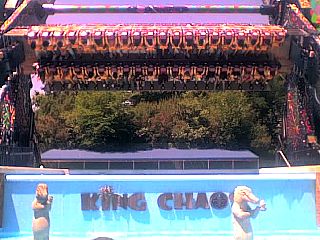
|
King Chaos is a common ride known as a "giant top spin" ride, themed in the Mardi Gras section of Six Flags in Gurnee, Illinois. The ride is basically a large "raft" that is lifted and turned in the air, hence the name "top spin". |
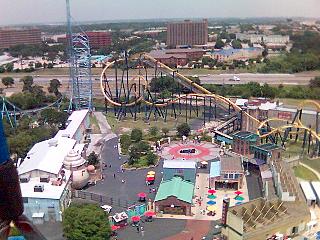
|
Here is a picture taken from the top of the parachute drop ride, the "Texas Chute-Out", at Six Flags over Texas near Dallas. This picture was also taken with a cellular-phone camera at roughly 250 feet above the park. The view shows two large coasters, "Mr Freeze" to the left, and "Batman, The Ride" to the right. Interstate 30 is in the background on the north side of the park. |
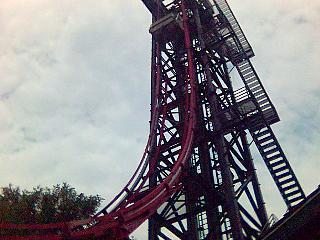
|
Here is a picture of a free-fall simulation ride at Six Flags over Texas near Dallas. Called the "Oil Derrick", a drop-pod holding 4 people is lifted 13 stories via an elevator, then dropped into free fall between guide rails. The car free falls, under gravity, then "levels out" onto horizontal tracks then braked and returned to the loading area. |
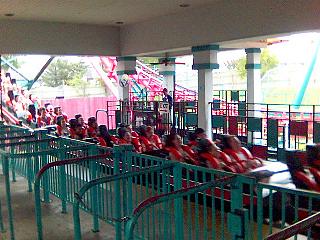
|
This is a picture taken of the loading area of the "Flashback" roller coaster at Six Flags over Texas near Dallas. The interesting thing here is that the train and guests are speeding through the loading area since the train is first pulled up the lift then released through the loading area and into the loops and hills after that, only to return the same way it came back to the station. |
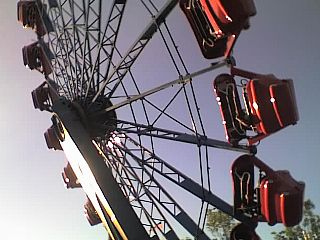
|
This is a classic ride called "The Enterprise" at Six Flags in Gurnee, Illinois. The ride is a classic upside-down ride developed by HUSS of Germany. Many such "Enterprise" rides can be called many different names, such as the "Witches Wheel" at Cedar Point, but are all basically very similar. The cars are bank-pivoted and at the rim of a large wheel, which turns to provide centrifugal force at about 2.5 G-units. A large hydraulic lift arm raises the spinning wheel to a vertical position, where riders are upside-down at the top of the rotating wheel. Once passengers are locked into their cars, there are actually no seatbelts or harnesses of any sort on this ride! The G-force vector remains positive Gz (into the seat) the entire time. |
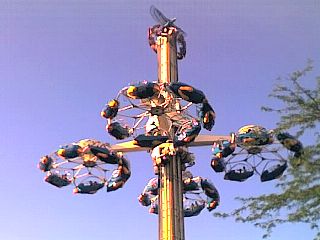
|
This is a tower ride called "The Condor" at Six Flags in Gurnee, Illinois. The ride is a large rotating hub section with four arms supporting independently rotating hubs, each of which contain seven bank-pivoted cars. The ride rotates and rises up to the top of the tower for a white-knuckle experience that's not for anyone with a fear of heights. |
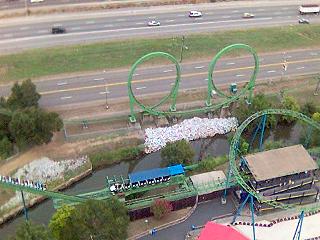
|
Here is a picture taken of the "Shockwave" roller coaster at Six Flags over Texas near Dallas. The coaster is small, but has two high-G clothoid shaped loops after its first drop. The picture was taken from the observation deck from a height of 280 feet on an Intamin lookout tower in the park. |
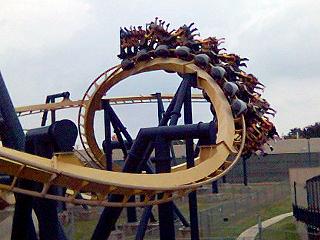
|
Here is a picture taken of one of the corkscrew inversions of the "Batman" roller coaster at Six Flags over Texas near Dallas. |
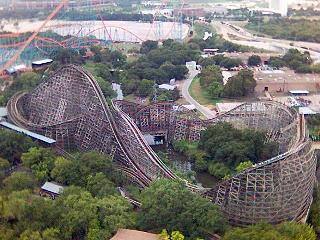
|
This is a picture of the "Texas Giant" wooden coaster taken from the top of the Intamin lookout tower at Six Flags over Texas near Dallas. This classic coaster design is not for the faint of heart because after its 143 foot drop you careen down steep banks and hills at 62-MPH while shaking as if you were on a home-built wooden wagon with loose wheels! The violence of this coaster is called the "Dinn Shuffle" since the builder, Dinn, incorporated shakers (slight bumps) in the tracks. |
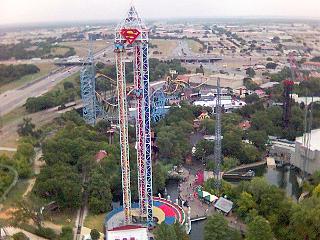
|
Also taken from the Intamin observation tower at Six Flags over Texas near Dallas, this picture shows the "Superman Tower of Power" ride where three 250 foot tall pneumatic catapults hurl park guests skyward then back down faster than gravity! Behind the Superman ride, you can also see the "Mr Freeze" and "Batman" coasters. The arched shaped truss structure to the right is a Skycoaster ride. |
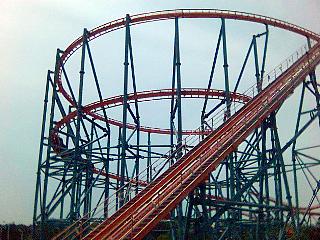
|
This is a picture of the ascending helix portion of the "Titan" roller coaster at Six Flags over Texas near Dallas. The train enters this meneuver just after completing its 255 foot drop and first hill. G-Forces here are SUSTAINED at 4.5 G units for about 10 seconds before exiting at the top of the helix. "Tunnel vision" is severe in the helix and I actually saw one person sitting next to me on the ride black out from the G-Force! The track in the foreground is the lift for the 255 foot hill. |
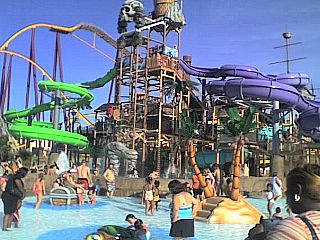
|
Six Flags often have many water parks, some adjacent to their major theme parks and admission to both is included at the main gate. This is the Hurricane Harbor water park at Six Flags in Gurnee, Illinois on a hot summer's day in July 2007. Water parks like this offer a day of fun for the entire family. |
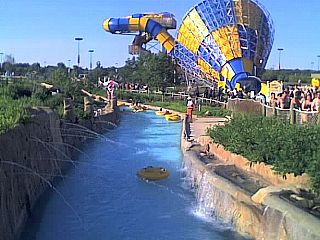
|
Here is a picture of the lazy river that meanders around the Hurricane Harbor water park at Six Flags in Gurnee, Illinois. Bathers ride the slow moving "river" in inflatable tubes. The lazy river has many waterfalls and sprays along its route. Many palm trees, which are not native to northern Illinois, are also brought in as part of the landscaping at Hurricane Harbor to boast a tropical theme. The large funnel-shaped structure in the background is the "Tornado" water-ride attraction. |
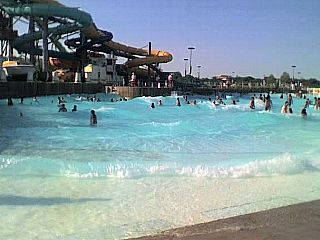
|
This is the "Hurricane Bay" wave pool at the Hurricane Harbor water park at Six Flags in Gurnee, Illinois. Since there are no oceans anywhere near the central United States, the only way to experience ocean-like waves is in a wave pool like this. |
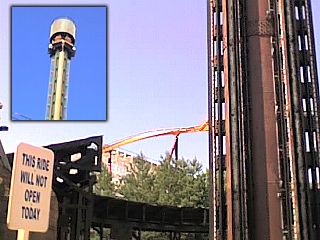
|
This is a picture of the Intamin drop-tower ride called "Giant Drop". The sign to the left says the disappointing news that "This ride will not open today". This drop ride was one of several that were forced to close after a tragic accident on an identical ride at a Six Flags in Kentucky left a young girl seriously injured. The cause was a frayed cable, and the girl's feet were severed. Intamin (a ride designer of Switzerland) needed to re-inspect and / or redesign such drop rides so that nothing like that ever happens again. With safety as an utter concern, all such drop tower rides were shut down. |
Cedar Point is a theme park on a penninsula that juts out into Lake Erie in Northern Ohio near Sandusky. This amazing place is coined "The Roller Coaster Capital Of The World" with least 17 roller coasters plus many other high-thrill attractions. Many roller coasters here have broken records for their sheer height (called "giga-coasters" or even "strata-coasters") with dizzying heights of 300 to well over 400 feet! In this special section, I have placed many pictures of some of the attractions at Cedar Point, many from actual on-ride footage! Cedar Point is open from May through October and thrills more than 3 million guests during that period.
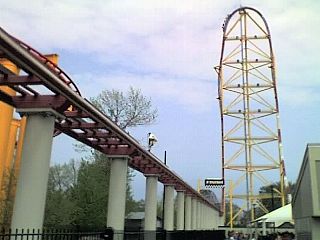
|
This is a view of the "Top Thrill Dragster" ride at Cedar Point in Sandusky, OH. Built by Intamin AG of Switzerland, this is a "strata-coaster" with a height of 420 feet and a gut-wrenching 10,000 horsepower hydraulic launch system capeable of accelerating an 18 passenger train from 0 to 120 MPH in under 4 seconds! The time it takes for the cars to launch, climb, descend, and return to the station along the 2,800 foot trach averages a mere 25 seconds. Magnetic brakes slow the cars after completing the ride. The view here is of the return track and the 420 foot high "vertical hair-pin" tower called a "top hat". |

|
This is one of many "fact" signs throughout the queue (waiting line) area for Top Thrill Dragster. This one compares the immense horsepower of the launch "engine" to that of a real "top fuel" dragster, 6,000 HP - Which is little over half that of the launch system on the Top Thrill ride. |
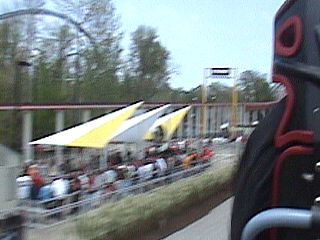
|
This is a picture (video frame-grab) of what it looks like during the launch phase on Top Thrill Dragster. In this picture, I am going roughly 60-70 MPH after about 2 seconds en-route to a final speed of 120-MPH after less than 4 seconds. Note the blurring affect starting as the train whizzes past the queue line. The feeling of this massive acceleration is overwhelming, slamming your head back into the padded seat and nearly ripping the hand-held video camera out of my hand. |
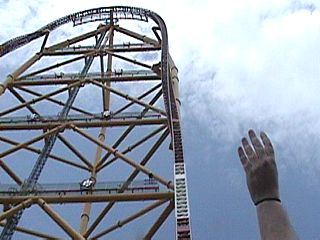
|
After about 4 seconds, the train, rocketing along with 18 people aboard at 120-MPH enters the climb phase of the 120-foot tower. This produces a 4-5 G-Force down into the seat and places you in a vertical climb (initially at 120-MPH straight up), very much like a "zoom climb" in an aircraft. The train also performs a 90-drgree roll in the vertical before reaching the top of the tower. In this picture, the view is skyward in a nearly vertical attitude, viewing up the track with another passenger's arm (in front of train) raised. |
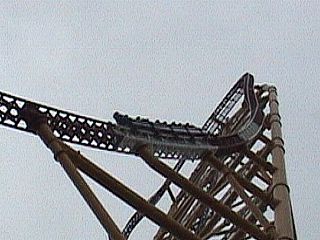
|
Here is another shot of the same "zoom climb" up to the top-hat of Top Thrill Dragster from the ground near the launch engine building. This is about where the train was on the track as the last POV picture above was taken. There is a speed indicator at this end as well, operated by a radar similar to the ones police use to catch speeders. On this launch, the display showed 122-MPH. |
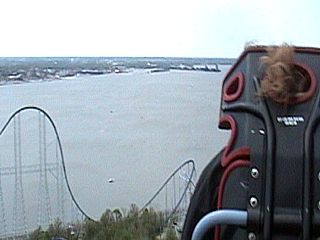
|
In about 10-15 seconds, the train is 420 feet above the ground, slowly cresting the top of the vertical "hair-pin" (top hat) tower in a nearly weightless (air-time) condition. In this picture, nearly the length of one and a half football fields in the sky, the 300+ foot high Millenium Force coaster is dwarfed surrounded by a birds-eye view of Sandusky, Cedar Point, and Lake Erie. Take it in quickly, because in about 2 seconds you will "free-fall" down the other side of the tower! |
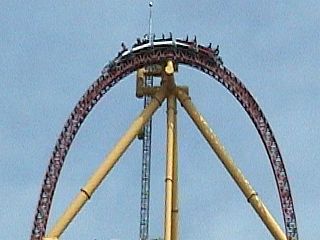
|
This is a shot of the Top Thrill Dragster's vertical "hair-pin" (top hat) tower with a train cresting its top and beginning its return down the other side. Sometimes, depending on weight and conditions, the train does not make it over the hill, and rolls backwards to the station. This is called a "roll back" and is not a big deal since magnetic safety brakes deploy to slow the train going backwards to the station as well. Rollbacks occur as frequently as 1 out of 5 launches. Much more rarely, a train can stop at the top of the hill, but can be released manually by an operator (the tower is equipped with an elevator as well). |
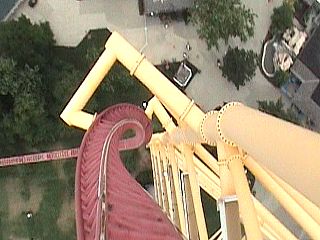
|
Be afraid. Be very afraid. Here is a white-knuckled shot from just past the crest of Top Thrill Dragster's top hat looking straight down at the train begins its descent. The 270-degree downward "roll" can be seen below us with the ground about 400 feet down since the train is in a vertical "attitude". |
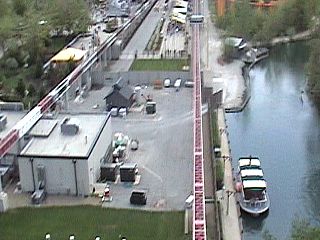
|
On the way back down, the train of Top Thrill Dragster accelerates to over 100-MPH and executes a 270-degree downward "roll" in the process. This picture was taken just after the roll, and about to return back to "level" track. Note the sign way at the end of the track that says "finish". The building to the lower left is the "engine room" where the launch equipment resides. Descent takes a mere 5 seconds to "fall" 420 feet. |
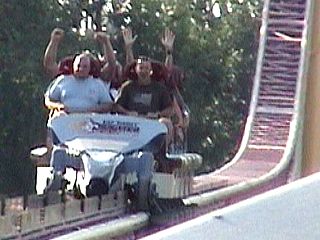
|
Here is a shot of the train of Top Thrill Dragster reaching the final stretch of the track at over 100-MPH and ready to be braked by the magnetic braking system. The magnetic brakes are the rows of metal "fins" sticking up from the top of the track just ahead of the speeding train. These are strips of metal (usually copper) that "react" with permanent magnets under the train to produce an electrical current inside the metal strips called an "eddy" current. The "eddy" current sets up its own magnetic field theough induction, opposite in pull to the inducing magnets under the train, so it slows the train down. The electrical currents induced inside the metal strips also make them very hot, and you can actually see heat rising (air "shaking") from them after a train passes. |
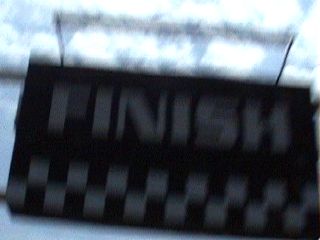
|
After 20-25 seconds, the ride is over and the "finish" sign rushes by in a blur! Magnetic brakes, some of them (most of them on the accelerating track to stop an occasional "roll back") deployed by an interesting set of air-powered actuators, slow the train down before reaching the station. This is like going 100-MPH in your car and stopping in about 3 seconds. |
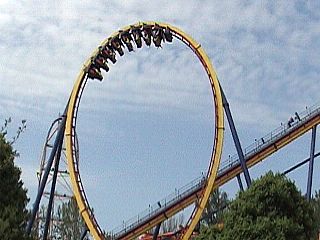
|
Here is a picture of the main loop (first inversion) of the Mantis roller coaster at Cedar Point. This loop is one of the largest vertical loops on any roller coaster, with a height of 119 feet. A train is upside down in this large loop in this picture. |
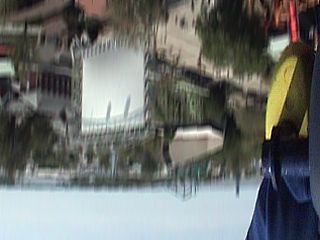
|
This picture is what a passenger (in the SAME position as the train in the first loop in the picture above) would experience on the Mantis roller coaster. The picture, in an inverted attitude, was taken as a frame-grab from a small camcoder while upside down. To the right is the stand-up seat of the person in front of me. To the left, is the inverted and blurred view of Cedar Point and a band-stage. |
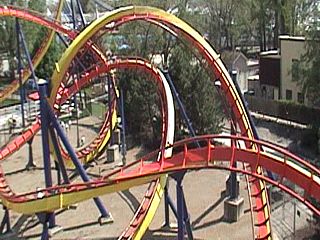
|
Here is another view of a twisting, meandering, and inter-mingling set of steel track while aboard the Mantis coaster. We are just about to drop again and make our way through those meneuvers. |
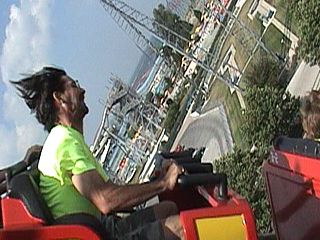
|
Gemini is a two-track wooden roller coaster known as a "racer". There are two trains, which are launched simultaneously, one red and one blue. Throughout most of the ride, both trains raced neck to neck, offering this unique view of the train next to us while diving down the first hill at a 55 degree angle and reaching speeds of 60-MPH! Our train (blue) wound up winning by a car's length! |
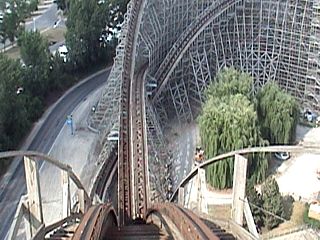
|
This is a picture of the view from the front seat at the top of the first 161 foot high 52-degree drop of the wooden coaster called "Mean Streak". This wooden coaster reaches speeds over over 65-MPH and has a ride time of nearly 3 minutes with 5,427 feet of track. |
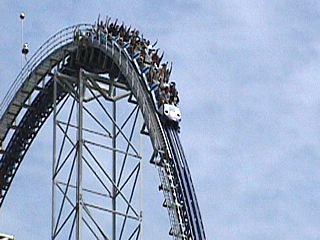
|
Millenium Force is an Intamin AG built large roller coaster that qualifies as a "giga-coaster", meaning it's more than 300 feet high. At 310 feet the train descends at an 80-degree angle and reaches speeds of 93-MPH. There are no inversions (loops) BUT the trains reach overbanked tracks (sort of like an aircraft "wing-over") at up to 122-Degrees and there are two "scream tube" tunnels. This coaster is similar to the "Steel Dragon" coaster in Japan. In this picture, a train begins its descent out of 310 feet. |
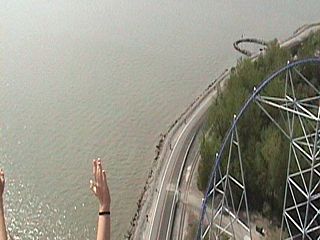
|
This is the view during the 310 foot descent about 1/3 way down the main hill of Millenium Force (taken from hand-held camcorder video). We are looking nearly straight down, with one's stomach in a knot, at Lake Erie, the bottom of the hill, a service road, and the GROUND. One passenger's hands are raised to the lower right. |
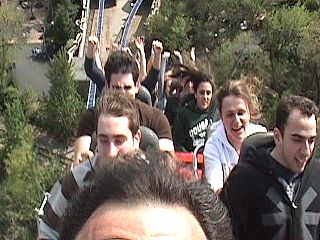
|
Here is a view looking back over my head as we crest the first "airtime hill" on Millenium Force. This is where you are lifted out of your seat by nearly weightless conditions. |
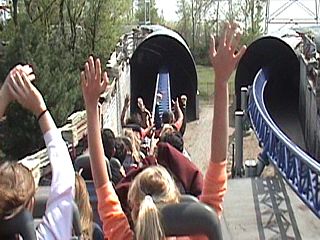
|
Here is another shot when just about to enter one of two "scream tubes" (tunnels) on the Millenium Force coaster at high speed. |
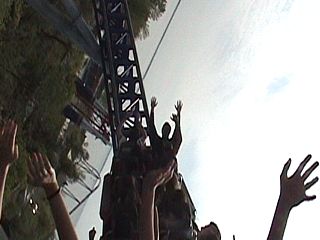
|
This picture shows what is known as an OVERBANKED TURN, where instead of a maxium of 90-degrees (sideways), the track performs a sort of "wing-over", and can bank at up to 122-degrees. This is because the track itself is banked, but also in a parabolic shape so that earth's gravity is eliminated due to a "push-over" meneuver, with all centrifugal force provided by the bank-turn itself. Not quite upside down, but close! |
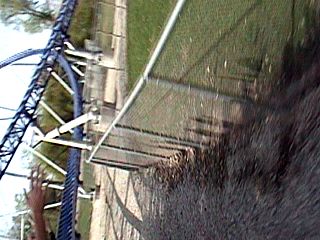
|
Here is another picture taken during a steep banked-turn. Note the "false-upright" effect (force pulls you "down" into the seat, but true "earth down" / ground is NOT where you are being pulled by). Our heads were just feet away from a fence at over 70-MPH. Also, shadows of the train and riders can be seen racing across the ground to the right! |
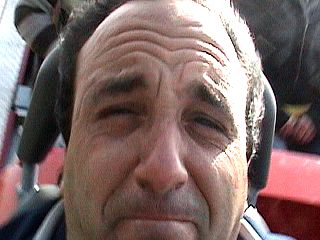
|
Here are the high G-force effects on my face while riding Millenium Force and in a steep turn. No, I really do not look like this! Such high G-force, approaching 5 times the pull of gravity, causes my 175-pound body to weigh 875-pounds, this is more than twice the weight of a Sumo wrestler! More obvious effects are the tremendous sagging of my skin (wrinkling) and "slanted-eyes" (tunnel vision). |
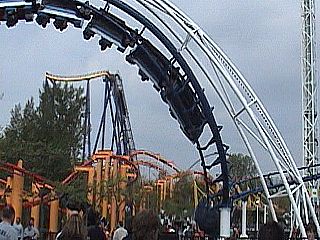
|
The Corkscrew roller coaster at Cedar Point is really unique because it's multiple cork-screw inversions are right over the heads of guests along the midway! It's so fun to be upside down, looking ABOVE you at people on the ground looking at you ABOVE them - Confused? |
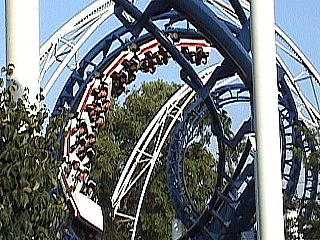
|
Here is a different view of the Corkscrew roller coaster at Cedar Point from a different vantage point. This coaster was built in 1976, has a lift hill of 85 feet, and a track length of 2,050 feet. Over a million people ride this coaster anually. |
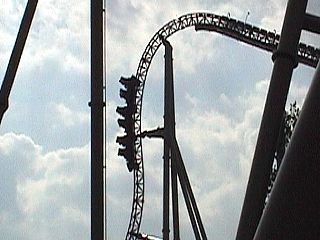
|
Maverick is a brand-new coaster at Cedar Point that was scheduled to open in May 2007, but was opened in June 2007 after working out some minor "bugs" with the track. In this picture, we can see one of the unique features of this ride, a 95-degree first drop, which is from over 100 feet. This does not SEEM like alot, but there is a LIM launch on the lift hill to about 40 MPH BEFORE a train "pushes over" into the 95-degree drop. This produces a negative G effect and extreme airtime. |
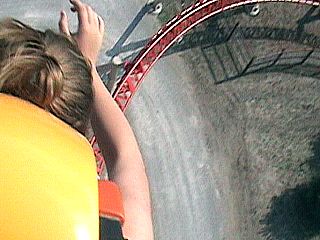
|
This is a POV of what the first drop of Maverick looks like to a rider (in this picture, the train is in about the same position as the off-ride picture of Maverick's first drop above). The ground is right in front of us, with an extra 5 degrees (from 90 degrees vertical) of "push" to it. The smoothness and "snappy" meneuvers of Maverick make this a big hit roller coaster. |
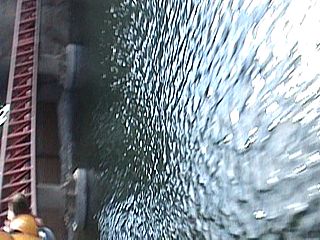
|
You think the ride on Maverick is over when the train slows down and enters the first tunnel. It's not. You are accelerated to 70-MPH by a LIM launcher and rocket over another hill then a lake in a steep banked turn. In this picture, we see the POV of the steep turn as the water of the lake rushes by just feet from us. |
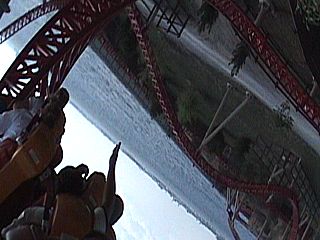
|
Unusual attitude? Here is another POV view of one of several inversions / over-banked turns on Maverick, providing the "false-upright" effect of being pulled DOWN into the seat when you are actually upside-down (relative to the earth, that is). |
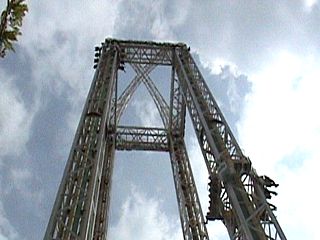
|
This is a picture of the "Power Tower" ride complex at Cedar Point. The structure is four box-trusses housing air-launch equipment on which of each a 16-passenger car rides. It is about 300 feet high. The designer is S & S Power, and has many of these air-launch rides operating. The Power Tower offers 2 different ride experiences. Two of the trusses lift the car to about 250 feet and drop them (turbo-drop experience). The other two allow an upward acceleration (space-shot experience). The compressed air also slows the vehicles in all cases with a bouncing effect. |
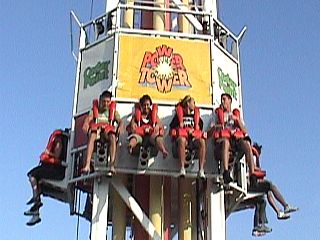
|
This is POV picture of on-ride footage of the "Power Tower" ride complex at Cedar Point. During the ride, we happen to "pass" another ride pod on one of the adjacent box trusses. |
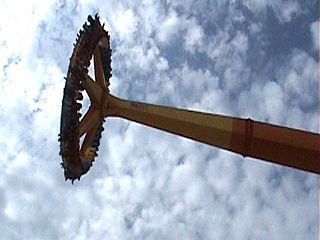
|
This is a "gyro-swing" (or "Giant Frisbee") ride at Cedar Point called "Maxair". It is basically a large swing with a rotating wheel at the end where 50 guests sit on the rim of the wheel. The arm swings (a 240-degree arc) the wheel to a height of 140 feet and reaches 70-MPH. The ride is built by HUSS (Germany) and is very similar to other Giant Frisbee rides such as "The Claw" built by Intamin AG. |
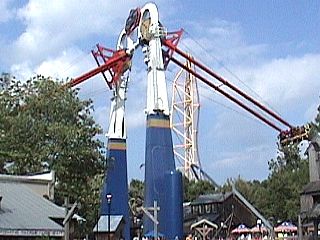
|
The "Skyhawk" is a giant "screaming swing" ride at Cedar Point. The structure itself is about 103 feet tall, making it the largest swing ride of that type in the World as of 2007. The swing has two arms, each holding 20 people in a pod at the end, with a 220 degree swing arc reaching heights of 125 feet and speeds over 60 MPH. Note the two large air tanks at the base of the ride. This is another air-thrust ride developed by S & S Power. |
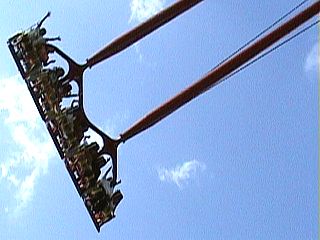
|
Here is a closeup of one of the passenger "pods" of the "Skyhawk" ride near full swing. Each of the two passenger pods is at the end of 84 foot arms that swing opposite of one another. Each pod has two rows of ten seats, seated back to back. The total capacity of the ride is 40 passengers with both pods (each holds 20). A tremendous amount of air pressure, stored in two large tanks at the base of the ride, provide the thrust to move the arms. |
Kings Island is a theme park about 20 minutes outside of Cincinnati in Mason, Ohio and is run by Cedar Fair (the same company that runs Cedar Point) and was formerly managed by Paramount Pictures. This place is not for the faint-of-heart as it too boasts some of the most amazing roller coasters, most-notably the record-breaking wooden coaster called "the Beast". In this special section there are many pictures of some of the attractions at Kings Island, many with actual on-ride footage! Kings Island is open from April through October and thrills millions of thrill-seeking guests during that period.
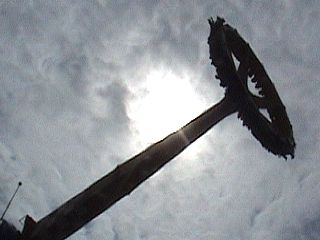
|
This is a picture (silhouetted against the sun) of another "giant frisbee" type ride called "Delirium". This is nearly identical to "Maxair" at Cedar Point where 50 people sit facing outward on a large wheel that rotates at 8 RPM while swinging in a 240-degree arc. The end of the "wheel" reaches a swing height of about 140 feet and speeds up to 70-MPH. The manufacturer is also HUSS (Germany) and competes with other giant frisbee rides made by Intamin (Switzerland) such as "The Claw" (smaller, seating 40 guests). |
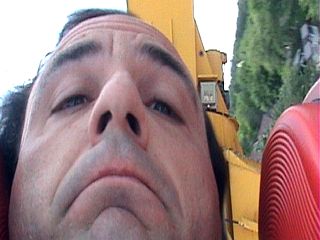
|
Here is a picture of myself, while riding the Delirium ride (giant frisbee) at nearly full-swing. The effects of traveling up to 70-MPH and spinning at 8 RPM with a 240-degree swing-arc become apparent in my face while 140 feet in the air! |
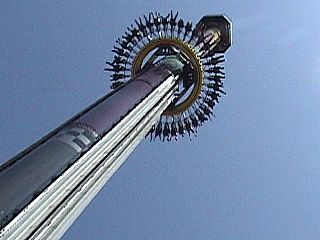
|
This is an Intamin (Switzerland) made "gyro drop" tower ride called "Drop Zone". Roughly 40 guests sit around the outer edge of a large "wheel" structure which is hoisted to a point near the top of a 300 foot tower. The structure also rotates on the way up to give riders a full 360-degree view of the Earth spreading out far below them. The structure stops at the top for a few seconds, and is released into free-fall, reaching speeds of 65-MPH before being stopped by magnetic brakes near the base. |
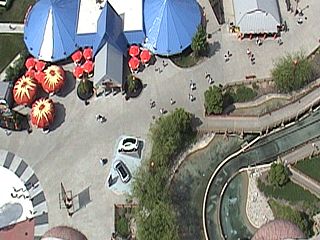
|
Here is a view looking down from the top of the Drop Zone ride just before being released into free-fall. If you have any kind of fear of heights - You may want to pass on this one! My knees can be seen to the lower left and lower right sides of this picture, below that, more than 250 feet of thin air. The tops of buildings, trees, and tents can be seen - And those are not "ants" but "people" down there! |
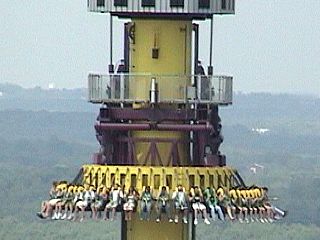
|
Taken from the observation deck of the Intamin "1/3 scale Eiffel tower", the Drop Zone ride near the top and is ready to be released into free-fall. A large "catch-car" and "dog" structure "clicks-in" to the wheel structure where the riders sit. Cables hoist the assembly to the drop point and the "dog" latches release the structure and riders into free-fall. |
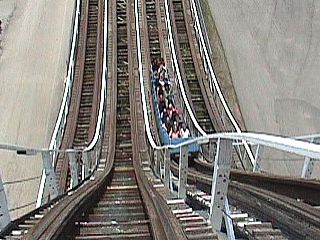
|
This picture was taken during the first drop from the front of the forward train on the wooden coaster called "Racer". This coaster is unique as there are two tracks, and one train on one goes forward, while the other goes backwards. Both trains "race" each other on the two separate and mainly parallel courses. The other (backward running) train is to the right and has "beaten" us down the first hill. |
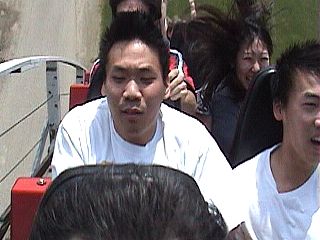
|
This is a view looking back at passengers behind me as the train crests an "airtime" hill on the Racer wooden coaster. At first glance you see everyone enjoying the ride, screaming, and having fun. But look closer as there are some interesting things going on. An "airtime" hill is like a negative-G "push-over" meneuver in an aircraft. This produces conditions where there are G-Forces LESS than Earth's normal gravity pull of 1 G. Here, there is close to zero G (weightlessness) or even slightly negative (Gz-) conditions. This causes people to actually "float" out of their seats until they reach the restraint systems. The Asian man in the center is "floating" and the zero-G effects can clearly be seen on the other woman tourist's long hair to the upper right. |
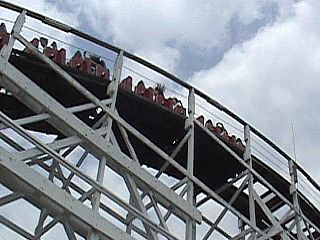
|
Here is a picture of one of the "airtime" hills on the Racer wooden coaster, most likely the same hill shown in the previous picture where the Asian tourists behind me were being lifted out of their seats. |
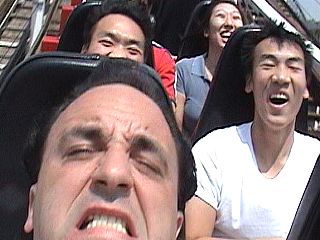
|
This is what it's all about - Thrills, chills, and ... Distorted faces? This picture (yeah, that's me to the lower left with my face succombing to the effects of the high G-Forces) is looking back from the front of the forward train on the Racer wooden coaster. In this picture, high positive G-Forces (Gz+) push me (and the tourists / guests behind me) down into the seat. |
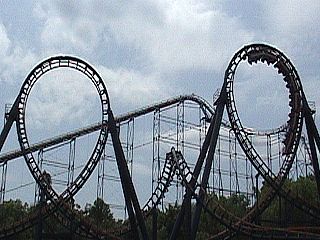
|
The "Vortex" roller coaster is a particularly high-thrill ride with 6 inversions (loops and upside-down meneuvers), a large "airtime" hill, and lots of steep high-G banked-turns. Here the 148' chain lift can be seen in the background and to main loops with the twin "corkscrew" roll in the foreground. The coaster train is in the first loop (to the right). |
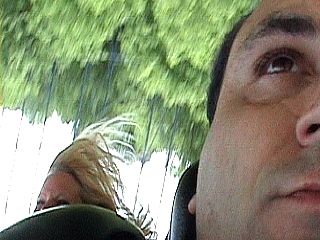
|
Here is a picture of myself, inverted while in one of the "corkscrew" rolls on the Vortex roller coaster. Note the other passenger behind me and the tree tops ABOVE us. |
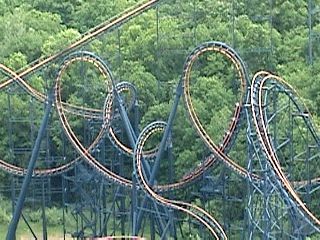
|
This is bird's eye view of the twin loops and "corkscrew" rolls of the Vorex coaster. This picture was taken from a 250 foot high Intamin observation platform (1/3 scale of Eiffel tower). It is interesting to see just how "artistic" the twists and turns of steel track appear as a train courses through them. |
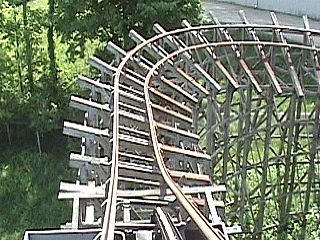
|
The "Adventure Express" is a smaller coaster known as a "mine-train" coaster. This makes the feel of being in a mine type train (sort of like in one of the "Indiana Jones" movies) hurtling out of control along a rickety track. One of the sharp bends unfolds before me in this POV picture from the front row of the train. This small family-oriented thriller has 4 themed tunnels (one with animated statues) and two lift hills. |
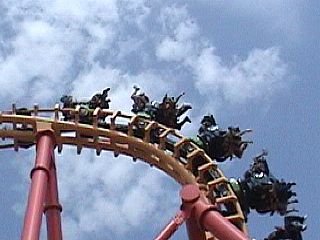
|
The roller coaster called "Face Off" is an inverted steel "shuttle" coaster, also known as a "boomerang". The lift pulls the train up from the loading station to about 160 feet and releases it. The train runs back through the station at high speed then enters the meneuvers. The train enters a second incline at the other end with a second lift and released again to go back through the menuevers and return to the station after being slowed by brakes on the original hill. In this picture, the train is in a "bow-tie" meneuver (one of 3 inversions). |
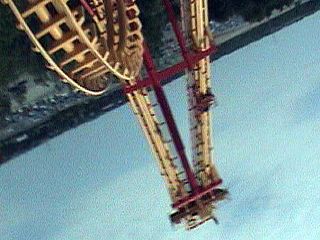
|
Here is a POV (riders point of view) while inverted in the "bow-tie" loop on the Face Off roller coaster. In this unusual (nearly inverted) attitude, the view of the top of the loop (foreground) and twin lift hills can be seen. |
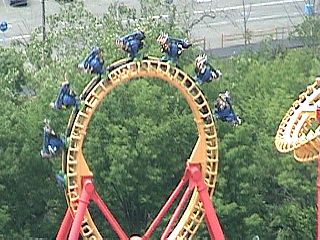
|
This is a bird's eye view of the main loop of the Vekoma built Face Off inverted shuttle coaster. This picture was taken from the observation deck of an Intamin structure in the center of the park (1/3 scale Eiffel tower). The train is inverted steel design (hangs down from the track) and each car has 2 seats facing forward and 2 facing aft. |
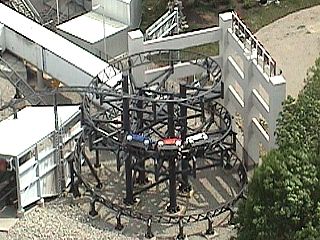
|
The "Italian Job Stunt Track" is a movie themed coaster / motion ride incorporating a LIM (linear induction motor) launch, high-G helix, and special effects including pyrotechnics. The themed ride has trains of three 3/4 scale MINI Cooper cars and starts with a rapid acceleration via LIM launcher into the first high-G helix meneuver (like entering a parking garage ramp at 40-MPH+). The helix is in this picture, viewed from above in the (1/3 scale "Eiffel") Intamin observation tower. |
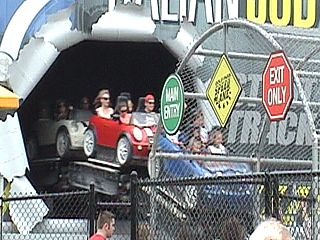
|
In the finale of the Italian Job Stunt Track ride, the train enters its last drop out of a tunnel and into a water-filled sump - just like one of the action scenes in the movie "The Italian Job" - complete with a water splash effect. |
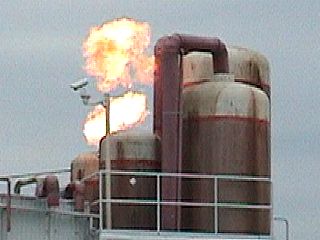
|
Large flames erupt above one of the sets for the Italian Job Stunt Track ride. This is a pyrotechnic (fire) effect simulating an explosion, one of many special effects incorporated into this interesting motion ride. |
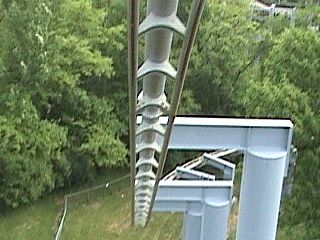
|
This is a front-seat POV picture of the descent on the "Top Gun" roller coaster just after the 78 foot lift. The unique thing about this coaster is that its train cars hang down from the inverted-steel track and swing left and right. Looking forward, there is the sense of "nothing" under you, giving a feeling of flight and steep banked turns. |
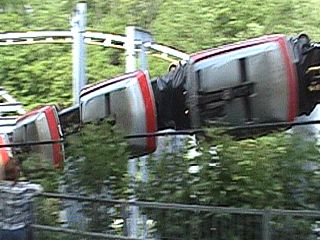
|
This is how the train cars move along a turn on the Top Gun roller coaster. The underside of the cars can be seen here as they are in a very steep, nearly over-banked turn. This effect produces a rider experience like "flying". |
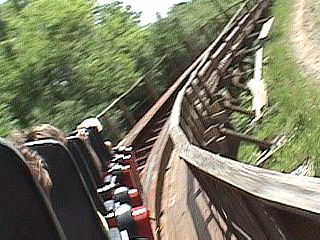
|
The "Beast" roller coaster is the largest wooden roller coaster in the world, with a track length of 7,359 feet, a ride time between 4 and 5 minutes, two 110 foot lift hills, and a shakey ride speed of nearly 65-MPH. This Dinn built coaster has the classic wooden "feel", with rattling and shaking making you almost fear for your life! This POV picture is from the middle of the train during a steep turn at high speed. |
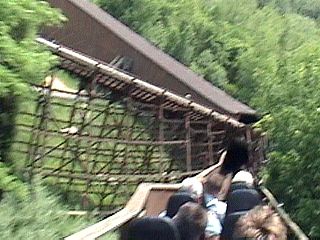
|
The second portion of the Beast roller coaster includes a listed (tilted) run into a tunnel at top speed in darkness with some of the most bone-jarring shaking imaginable. In this POV picture from the center of the train, we are accelerating down a steep grade and about to enter a long wooden tunnel. |
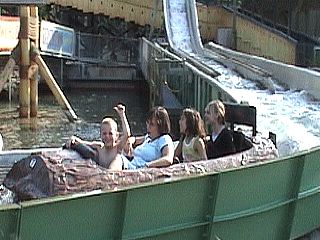
|
Here is a picture of a log ride, or "flume". These are not true roller coasters, as they are basically a large water-slide inwhich passengers ride in boat-like vessels. This one has log-shaped "boats" and offers a cool and wet experience on those hot summer days - The child in the front sure is one happy rider! |
Sit down and hang on ... and "Know Fear"! This is a section showing some of the most craziest extreme rides that do not really fall into the category of "midway" rides found at many theme parks and fairs. These rides are often "specialty" attractions, requiring an extra fee in addition to the entrance fee for the park / fair to go on. They are also much more intimidating, such as the "Ejection Seat" or "Slingshot" ride ... Where you are strapped into a metal "cage" and shot over 300 feet into the sky at nearly 100 MPH! Other specialty attractions fall into this category. These attractions can be found at both traveling fairs (county fairs) as well as fixed installations such as theme parks.
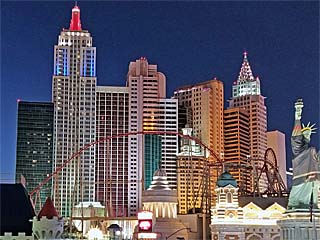
|
This is a picture of a portion of "The Roller Coaster" (also known as the "Big Apple Coaster") at the New York New York Hotel and Casino in Las Vegas, Nevada in October 2018. It's uniquely nestled within the buildings and architecture of the city despite it having over 4,700 feet of track. |
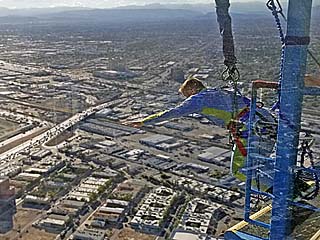
|
This is a view from the 855 foot level of the Stratosphere Tower in Las Vegas, Nevada in October 2018 of someone leaping off the jump platform of the "SkyJump" extreme ride. This is a record breaking "high fall" descender type system (based on a concept and prototype developed many years ago by stuntman Dar Robinson) using cables and guide wires to rapidly lower jumpers to the street below at up to 45 MPH. So yes, you are basically jumping off a tall skyscraper / tower! |
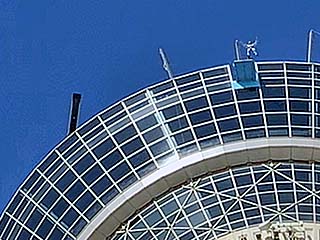
|
Here is a picture, taken from street level, of me leaving the "SkyJump" platform 855 feet up - Look closely and you'll see a tiny man just off the ledge! |
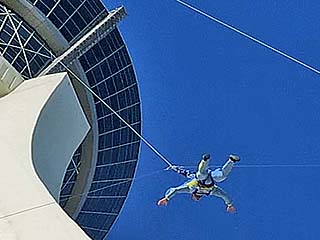
|
Another view of me descending rapidly down on the "SkyJump" extreme ride in Las Vegas. |
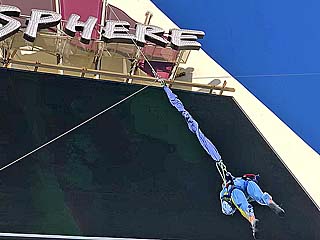
|
Myself coming to a rapid stop at about 3 Gs near the bottom of the "SkyJump" extreme ride in Las Vegas after a controlled fall of 855 feet off the Stratosphere Tower. |
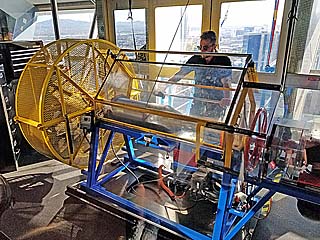
|
View of the unique mechanism that allows jumpers to safely jump off the Stratosphere Tower in Las Vegas. The machine is developed by Jump Technics and is the highest "descender" type ride in the world (according to Guinness) as of 2018. The large fan (called a "PowerFan") to the left in the yellow shroud creates drag to dissipate the fall energy. The cable is wound about a special high speed winch system with motor (for re-winding the nearly 900 feet of steel cable) and braking mechanism (center and to the right). Stuntman Dar Robinson came up with this idea long ago and tested a prototype of such a "descender" in Toronto, jumping off the CN Tower and falling 700 feet in the early 80s for a stunt jump in the movie "Highpoint". Since then, many improvements and fail safes have been added, making these machines used in many TV and movie stunts. Finally, such a device allows relatively safe jumps for thrill seekers daring enough to jump from the highest of such installations in the world. |
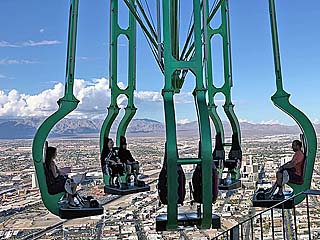
|
Here is a view of a flat (spin) thrill ride called "Insanity" at the Stratosphere Tower in Las Vegas. This is on a large arm that swings out past the precipice of the tower, over 86 stories up, and spins with up to 3Gs of dizzying vertigo. The ride as 5 arms, each accommodating up to 2 thrill seekers (10 total per ride cycle). |
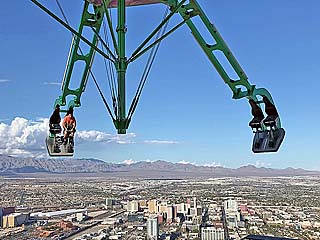
|
The "Insanity" ride in full spin at the Stratosphere Tower in Las Vegas. The fact that your spinning with 3Gs of force, 860+ feet up, is what makes this ride unique. If you get sick on any ride that spins and / or goes fast AND are afraid of heights = Avoid this ride like the plague! |
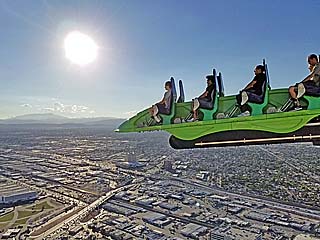
|
This is another extreme thrill ride atop the Stratosphere Tower in Las Vegas. This one is called "X-Scream" and in itself is a rather simple ride, basically a giant teetering "see-saw" ... But the difference is that it's over 86 stories above the Las Vegas strip and near / over the edge of the observation tower itself! The ride tilts back and forth, and the car rolls OVER the edge at 30 MPH, then coming to a hard stop. The feeling - Especially in the front seat - Is that of certain doom as if feels like your just going to keep going and you see nothing below you! An acrophobiac's "worst nightmare and guarantee of cardiac arrest". For myself = Death grip on seat handles and hoping "a bolt don't shear off"! |
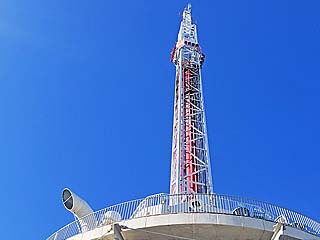
|
Although "tamer" (in respect that your not over the edge of the tower) but still not for the faint of heart, the "Big Shot" attraction at the Stratosphere Tower in Las Vegas allows a rapid ascent up below the antenna spire from 921 feet to 1,081 feet at an acceleration of 4Gs. It is an S&S air power ride using a pneumatic launcher similar to many other installations around the world at theme parks. This one is just atop the tallest point of the Stratosphere tower, making it one of the highest installations around the world (there's one at the Canton Tower in China that is higher). Atop this attraction, and using some of the trussing for support, are the antennas for KOAS and KVGS, topping out at 1,149 feet. |
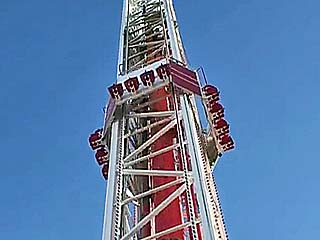
|
Another view of the "Big Shot" attraction at the Stratosphere Tower in Las Vegas in October 2018 from the ~920 foot level looking up. |
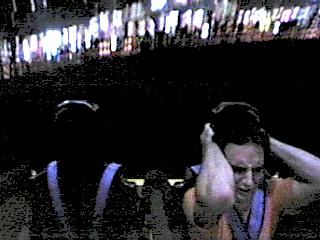
|
The "Ejection Seat" ride is a small gondola attached to two reverse bungee cords. When released, the sling shot effect catapults you to 200 feet in seconds. The time to accelerate from 0 to 70 MPH is under a second and produces a G-Force load of 4.2 G's. This picture is me at the top of the ride (in an upside-down attitude) just after being fired off. |
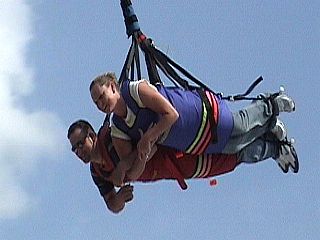
|
The "Sky Coaster" is an extreme ride combining the thrill of skydiving and bungee jumping via special harness system attached to a cable inwhich one to three riders swing. The ride is basically a large swing, where the riders hang from a cable attached to the center of an arch or high A-frame structure. Another winched cable attached to the harness system brings the rider(s) up to a height ranging from 100 feet, to over 300 feet on some of the largest Sky Coasters. The riders pull a rip-cord on the harness to release into a free-fall then swing through the air at speeds exceeding 70-MPH. In this picture, two riders are enjoying a swing from about 150 feet at Kings Island park in Ohio. |
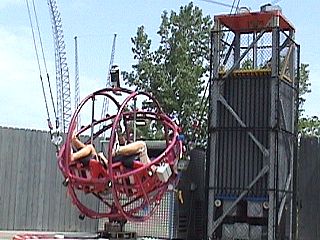
|
This is one of the newer "Ejection Seat" rides that use a different launch system than bungee cords. This is the metal cage / gondola inwhich one or two riders are harnessed-up in. This version (at Kings Island in Ohio) is called a "Sling Shot", and is capable of launching riders about 270 feet into the air at an upward speed of over 85-MPH. In the background is a "spring machine". This is where the launch-energy is stored, and the springs are stretched via a 40-ton hydraulic jack as the gondola is held on the ground plate by a magnetic and pin release. When the pin is released, the gondola begins its skyward "rocket ride" through a system of pulleys, subjecting the riders to a G-Force of 4 to 6 G's. |
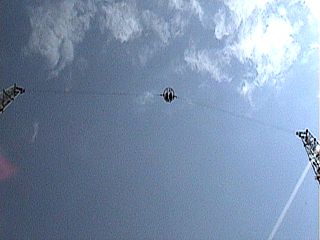
|
This is how high the Slingshot ride (at Kings Island in Ohio) gondola and it's riders are after a mere 2 seconds after launch at the "apogee". The riders are about 270 feet in the air, only to return back down in pure free-fall guided by the cables, which also serve as a brake as well. Once the riders have slowed, the gondola is lowered back to the ground. |
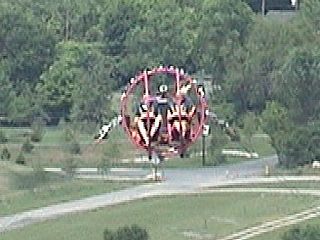
|
Here is another view, taken as Kings Island from the Intamin (1/3 scale Eiffel) observation tower of the Slingshot ride gondola and it's riders in mid air. Beleive it or not, there are Slingshot rides that launch riders skyward at over 100-MPH to 375 feet, particularly in Orlando, FL. These rides, although faster than the bungee "Ejection Seat" rides, operate much more smoothly. |
| COASTER-NAME | LOCATION | TRACK | TYPE | LIFT | HEIGHT | LENGTH | SPEED | GFORCE | INV | COMMENTS |
| Adventure Express | Mason, OH (USA) | Circuit | Steel | Chain (2) | 63' | 2,963' | 35-MPH | 3g | 0 | Mine-Train Design |
| American Eagle | Gurnee, IL (USA) | Circuit (2) | Wood | Chain | 147' | 4,650' | 66-MPH | >3.5g | 0 | Blue & Red Racer! |
| Atom Smasher | Rockaway, NY (USA) | Circuit | Wood | Chain | 70' | 3,000' | 50-MPH | 3g | 0 | Closed 1985 |
| Backlot Stunt Coaster | Vaughan, ON (Canada) | Circuit | Steel | LIM | 45' | 1,960' | 40-MPH | >4g | 0 | Same Design As Italian Job (Ohio) |
| Batman The Ride | Dallas, TX (USA) | Circuit | Inv-Steel | Chain | 105' | 2,700' | 50-MPH | 4g | 5 | Six Flags Over Texas |
| Batman The Ride | Gurnee, IL (USA) | Circuit | Inv-Steel | Chain | 109' | 2,700' | 50-MPH | 4g | 5 | Six Flags Great America |
| Batman The Ride | Valencia, CA (USA) | Circuit | Inv-Steel | Chain | 100' | 2,700' | 50-MPH | 4g | 5 | Six Flags Magic Mountain |
| Behemoth | Vaughan, ON (Canada) | Circuit | Steel | Chain | 230' | 5,318' | 77-MPH | 4.5g | 0 | N/A |
| Big Apple Coaster | Las Vegas, NV (USA) | Circuit | Steel | Chain | 203' | 4,777' | 67-MPH | 4g | 2 | Virtual Reality Offered |
| Big Spin | Dallas, TX (USA) | Circuit | Steel | Chain | 53' | 1,351' | 31-MPH | <2g | 0 | Tony Hawk's Experience |
| Canobie Corkscrew | Canobie Lake, NH (USA) | Circuit | Steel | Chain | 73' | 1,200' | 45-MPH | 3g | 2 | N/A |
| Colossus | Valencia, CA (USA) | Circuit (2) | Wood | Chain | 125' | 4,235' | 62-MPH | 3.0g | 0 | Classic Wood Racer! |
| Corkscrew | Cedar Point, OH (USA) | Circuit | Steel | Chain | 85' | 2,050' | 48-MPH | 3.5g | 3 | Inversions OVER Crowd! |
| Crazy Mouse | County Fair(s) | Spinner | Steel | Chain | 49' | 1,377' | 25-MPH | <2g | 0 | Some Spinning Car / Dark-Ride Versions |
| Cyclone | Coney Island, NY (USA) | Circuit | Wood | Chain | 85' | 2,640' | 60-MPH | 3g | 0 | 1927 Classic! |
| Dark Knight | Gurnee, IL (USA) | Circuit | Steel | Chain | 45' | 1,213' | 30-MPH | 2.5g | 0 | Wild-Mouse Dark-Ride |
| Deja Vu | Gurnee, IL (USA) | Shuttle | Inv-Steel | Catch-Car | 191' | 1,204' | 66-MPH | 4g | 6 | Lift Then Drop Lift |
| Deja Vu | Valencia, CA (USA) | Shuttle | Inv-Steel | Catch-Car | 191' | 1,204' | 66-MPH | 4g | 6 | Magic Mountain's Version |
| Demon | Gurnee, IL (USA) | Circuit | Steel | Chain | 102' | 2,130' | 50-MPH | 3.5g | 4 | Barrel Roll Loop Finale! |
| Disaster Transport | Cedar Point, OH (USA) | Bobsled Circuit | Steel Chute | Chain | 63' | 1,932' | 40-MPH | 2g | 0 | Bobsled Dark-Ride! |
| Doppel Looping | County Fair(s) | Circuit | Steel | Chain | 89' | 2,086' | 45-MPH | 3.5g | 2 | N/A |
| Dragon Fire | Vaughan, ON (Canada) | Circuit | Steel | Chain | 78' | 2,160' | 50-MPH | 4g | 4 | N/A |
| Dueling Dragons | Orlando, FL (USA) | Circuit (2) | Inv-Steel | Chain | 127' | 3,200' | 60-MPH | 4g | 5 | Steel Racer |
| Face Off | Mason, OH (USA) | Shuttle | Steel | Rev-Chain | 160' | 1,013' | 50-MPH | >3g | 3 | N/A |
| Firehawk | Mason, OH (USA) | Shuttle | Horiz-Steel | Chain | 115' | 3,340' | 55-MPH | 4.3g | 7 | Horiz & on-your-back Ride! |
| Flight Deck | Vaughan, ON (Canada) | Circuit | Steel | Chain | 109' | 2,261' | 50-MPH | 4g | 5 | N/A |
| Flight Of Fear | Mason, OH (USA) | Circuit | Steel | LIM | 74' | 2,705' | 55-MPH | 4.5g | 4 | LIM & Dark-Ride! |
| Flashback | Dallas, TX (USA) | Shuttle | Steel | Rev-Chain | 125' | 875' | 50-MPH | >3g | 3 | N/A |
| Full Throttle | Valencia, CA (USA) | Shuttle | Steel | LIM | 160' | 2,200' | 70-MPH | 4g | 2 | Record-Breaking Loop Height! |
| Galaxy | County Fair(s) | Circuit | Steel | Chain | 45' | 1,919' | 35-MPH | 2.5g | 0 | Very Common |
| Gemini | Cedar Point, OH (USA) | Circuit (2) | Wood | Chain | 125' | 3,935' | 60-MPH | 3.5g | 0 | Figure-8 Racer! |
| Goliath | Gurnee, IL (USA) | Circuit | Wood | Chain | 180' | 3,100' | 72-MPH | 3g | 2 | Record-Breaking Wood Coaster! |
| Goliath | Valencia, CA (USA) | Circuit | Steel | Chain | 255' | 4,500' | 85-MPH | 4.0g | 0 | Hyper-Coaster |
| Gwazi | Tampa, FL (USA) | Circuit (2) | Wood | Chain | 90' | 3,400' | 50-MPH | 3.5g | 0 | Wooden Goodie! |
| Incredible Hulk | Orlando, FL (USA) | Circuit | Steel | Friction-Wheels | 105' | 3,970' | 60-MPH | >4g | 7 | Heart Attack! |
| Iron Dragon | Cedar Point, OH (USA) | Circuit | Inv-Steel | Chain (2) | 76' | 2,800' | 40-MPH | 2.5g | 0 | Suspended, 2 Lifts! |
| Iron Wolf | Gurnee, IL (USA) | Circuit | Steel Stand-Up | Chain | 100' | 2,900' | 55-MPH | >3g | 2 | Stand-Up Ride! |
| Italian Job Stunt Track | Mason, OH (USA) | Circuit | Steel | LIM | 36' | 1,960' | 40-MPH | >4g | 0 | Has Special FX |
| Journey To Atlantis | Orlando, FL (USA) | Circuit | Steel+Flume | Chain | 60' | N/A | 45-MPH | 2-3g | 0 | You're Wet! |
| Sun World Khu Alpine Coaster | Ba Na Hills, De Nang (Vietnam) | Circuit | Steel | Self Launched / Hill | 200' | 7,920 | 30-MPH | 2g | 0 | Mountain Coaster Above The Clouds! |
| Kraken | Orlando, FL (USA) | Circuit | Steel | Chain | 149' | 4,177' | 65-MPH | >4g | 7 | Fun! |
| Kumba | Tampa, FL (USA) | Circuit | Steel | Chain | 143' | 3,978' | 65-MPH | 3.8g | 7 | N/A |
| La Vibora | Dallas, TX (USA) | Bobsled Circuit | Steel Chute | Chain | 60' | 1,490' | 32-MPH | <2g | 0 | Like a Bobsled! |
| Leviathan | Vaughan, ON (Canada) | Circuit | Steel | Chain | 306' | 5,486' | 92-MPH | 4.5g | 0 | Highest Canadian Coaster (2013) |
| Lightning Loops | Jackson, NJ (USA) | Shuttle | Steel | Catch-Car | 56' | 635' | 45-MPH | 4g | 1 | Closed 1992 |
| Looping Star | County Fair(s) | Circuit | Steel | Chain | 36' | 1,197' | 40-MPH | 2.5g | 1 | Nice Lil' Loop! |
| Magnum XL-200 | Cedar Point, OH (USA) | Circuit | Steel | Chain | 205' | 5,106' | 72-MPH | 4.5g | 0 | Mucho Airtime! |
| Mako | Orlando, FL (USA) | Circuit | Steel | Chain | 200' | 4,760' | 73-MPH | 4g | 0 | Largest Coaster In Orlando (As Of 2017) |
| Manta | Orlando, FL (USA) | Circuit | Horiz-Steel | Chain | 140' | 3,359' | 56-MPH | 3.7g | 4 | Horizontal Riding |
| Mantis | Cedar Point, OH (USA) | Circuit | Steel Stand-Up | Chain | 145' | 3,900' | 60-MPH | 3g | 4 | Another Stand-Up! |
| Maverick | Cedar Point, OH (USA) | Circuit | Steel | LIM (2) | 105' | 4,450' | 70-MPH | 4g | 2 | 95-Degree Drop! |
| Mean Streak | Cedar Point, OH (USA) | Circuit | Wood | Chain | 161' | 5,427' | 66-MPH | 3g | 0 | Dinn Shuffle! |
| Mighty Canadian Minebuster | Vaughan, ON (Canada) | Circuit | Wood | Chain | 90' | 3,828' | 56-MPH | 3g | 0 | Philadelphia Toboggan Coaster |
| Millenium Force | Cedar Point, OH (USA) | Circuit | Steel | Cable Lift | 310' | 6,595' | 93-MPH | >4g | 0 | 80 Degree Drop! |
| Montu | Tampa, FL (USA) | Circuit | Inv-Steel | Chain | 150' | 3,983' | 65-MPH | 3.8g | 7 | My Favorite! |
| Mr Freeze | Dallas, TX (USA) | Shuttle | Steel | LIM | 218' | 1,382' | 70-MPH | 4.1g | 2 | Wow! |
| Ninja | Valencia, CA (USA) | Circuit | Inv-Steel | Chain | 60' | 2,700' | 55-MPH | 2.9g | 0 | Suspended Cars! |
| Primeval Whirl | Orlando, FL (USA) | Spinner (2) | Steel | Chain | 49' | 1,377' | 25-MPH | <2g | 0 | Cars Spin! |
| Python | Tampa, FL (USA) | Circuit | Steel (2) | Chain | 70' | 1,200' | 45-MPH | 3g | 2 | N/A |
| Racer | Mason, OH (USA) | Circuit (2) | Wood | Chain | 88' | 3,415' | 61-MPH | >3.5g | 0 | Racer Design |
| Raging Bull | Gurnee, IL (USA) | Circuit | Steel | Chain | 208' | 5,057' | 73-MPH | >4.5g | 0 | 65-Deg First Drop! |
| Raptor | Cedar Point, OH (USA) | Circuit | Steel | Chain | 137' | 3,790' | 57-MPH | >4g | 6 | Many Inversions! |
| Revolution | Valencia, CA (USA) | Circuit | Steel | Chain | 113' | 3,457' | 55-MPH | 4.9g | 1 | First Modern Loop Coaster! |
| Riddler's Revenge | Valencia, CA (USA) | Circuit | Steel Stand-Up | Chain | 156' | 2,900' | 67-MPH | 4.2g | 6 | Stand-Up And Flip Many! |
| Rock n' Roller Coaster | Orlando, FL (USA) | Indoor | Steel | LIM | 80' | 3,403' | 57-MPH | 5g | 3 | Hole-Shot! |
| Rolling Thunder | Jackson, NJ (USA) | Circuit | Wood | Chain | 96' | 3,200' | 56-MPH | 3g | 0 | N/A |
| Runaway Mountain | Dallas, TX (USA) | Indoor | Steel | Chain | 51' | 1,500' | 40-MPH | >5.2g | 0 | N/A |
| Scorpion | Tampa, FL (USA) | Circuit | Steel | Chain | 65' | 1,805' | <50-MPH | 3.5g | 1 | N/A |
| Scream | Valencia, CA (USA) | Circuit | Steel | Chain | 150' | 3,895' | 63-MPH | 3.5g | 7 | Floorless Coaster |
| Shockwave | Dallas, TX (USA) | Circuit | Steel | Chain | 116' | 3,500' | 60-MPH | 5.9g | 2 | Two High G Loops! |
| Skyrider | Vaughan, ON (Canada) | Circuit | Steel Stand-Up | Chain | 92' | 2,231' | 50-MPH | 4g | 1 | N/A |
| Space Mountain | Orlando, FL (USA) | Indoor | Steel | Chain | 95' | 3,459' | 45-MPH | 3g | 0 | 1970's Thriller! |
| Superman The Escape | Valencia, CA (USA) | Twin Shuttle | Steel | LIM | 415' | 1,235' | 100-MPH | 5g | 0 | 90-Deg "Ballistic" Track |
| Superman Ultimate Flight | Gurnee, IL (USA) | Circuit | Horiz-Steel | Chain | 106' | 2,798' | 51-MPH | 3.5g | 2 | You Ride Horizontally! |
| Tatsu | Valencia, CA (USA) | Circuit | Horiz-Steel | Chain | 170' | 3,602' | 62-MPH | 4g | 4 | Horizontal Fly Position! |
| Test Track | Orlando, FL (USA) | Circuit | Steel | Motion Vehicle | 40' | 5,246' | 68-MPH | 3-4g | 0 | Ride + Speed Test |
| Texas Giant | Dallas, TX (USA) | Circuit | Wood | Chain | 143' | 4,920' | 62-MPH | 2.7g | 0 | Hot-Damn! |
| The Bat | Vaughan, ON (Canada) | Shuttle | Steel | Chain | 117' | 930' | 47-MPH | 5.2g | 3 | N/A |
| The Beast | Mason, OH (USA) | Circuit | Wood | Chain (2) | 110' | 7,359' | 64.8-MPH | 3.1g | 0 | Hold On!! |
| Thunder Mountain Railroad | Orlando, FL (USA) | Circuit | Steel | Chain | 50' | 2,500' | 30-MPH | 2g | 0 | Mild Coaster! |
| Time Warp | Vaughan, ON (Canada) | Circuit | Steel | Unique Spiral Lift | 50' | 1,282' | 26-MPH | 3g | 2 | N/A |
| Titan | Dallas, TX (USA) | Circuit | Steel | Chain | 255' | 5,280' | 85-MPH | 4.5g | 0 | Tunnel Vision! |
| Top Gun | Mason, OH (USA) | Circuit | Inv-Steel | Chain | 78' | 2,532' | 51-MPH | 2.5g | 0 | Suspended Cars! |
| Top Thrill Dragster | Cedar Point, OH (USA) | Circuit | Steel | Hydraulic Launch | 420' | 2,800' | 120-MPH | 5g | 0 | 10,000 Horsepower! |
| Twisted Collosus | Valencia, CA (USA) | Mobius Circuit | Steel | Chain | 128' | 4,990' | 57-MPH | 4g | 2 | Almost 4 Minute Ride! |
| Vertical Velocity | Gurnee, IL (USA) | Shuttle | Inv-Steel | LIM | 185' | 630' | 70-MPH | >4g | 0 | Twisted Impulse Design (90 Deg) |
| Viper | Gurnee, IL (USA) | Circuit | Wood | Chain | 100' | 3,458' | 50-MPH | 2.5g | 0 | Nice Wood Coaster! |
| Viper | Valencia, CA (USA) | Circuit | Steel | Chain | 188' | 3,830' | 70-MPH | 4.1g | 7 | High First-Loop |
| Vortex | Mason, OH (USA) | Circuit | Steel | Chain | 148' | 3,800' | 55-MPH | >3.5g | 6 | Scary |
| Wicked Twister | Cedar Point, OH (USA) | Shuttle | Inv-Steel | LIM | 215' | 2,700' | 72-MPH | >4g | 0 | 450-Deg Vertical Rolls! |
| Wild beast | Vaughan, ON (Canada) | Circuit | Wood | Chain | 82' | 3,150' | 56-MPH | 3g | 0 | Philadelphia Toboggan Coaster |
| Willards Whizzer | Gurnee, IL (USA) | Circuit | Steel | Powered Track | 70' | 3,100' | 42-MPH | >3g | 0 | Speed Racer / Spiral Lift |
| X-2 | Valencia, CA (USA) | Circuit | Steel (4D) | Chain | 215' | 3,610' | 76-MPH | 4g | 2 | Seats Pitch (4th Dimension)! |
| X-Flight | Gurnee, IL (USA) | Circuit | Steel (Wing) | Chain | 120' | 3,000' | 55-MPH | 3.5g | 5 | "Wing" Seating Design |
| Yankee Cannonball | Canobie Lake, NH (USA) | Circuit | Wood | Chain | 70' | 2,000' | 35-MPH | 2.5g | 0 | 1937 Classic! |
The table above shows most of the rides that classify as "roller-coasters" in my life. Such rides require a track and work on basic roller-coaster physics. Water-flumes, slides, spinning rides, and kiddie rides do NOT classify as roller-coasters. Note that the "Atlantis" ride above is in this list because a portion of it is a true roller-coaster. Two main types of coasters exist today, wood and steel. The steel being the newer, faster, leading-edge technology and the wood being the older but classically different type of coaster. Wood coasters are still being built today because of this. Like maneuvers in an airplane, roller-coasters create all kinds of G-Forces, ranging from as little as 2 to well over 5 times the force of gravity (G), depending on the coaster nature. The speed of the coaster constantly changes throughout the ride but is stated above as the highest speed for that ride. Most roller-coasters use the tried and true chain lift to bring the car or train to the top of a tall hill and let gravity take it from there. Another type of motion inducer is the launcher type. Launcher type roller coasters use powerful motors, LIMs (linear induction motors), or even compressed air to rapidly accelerate the car(s). Such coasters operate without a lift and hill and can immediately enter the maneuver(s) after acceleration. The "Mr Freeze" coaster above uses LIMs (Linear Induction Motors) to accelerate occupants to 70 MPH in only 3 seconds followed by a 90 degree ascent up a 218' tower! Furthermore, the "Top Thrill Dragster" ride uses a 10,000 horsepower hydraulic launch system to propel vehicles at a mind blurring 120-MPH in under 4 seconds! Remember, a roller-coaster respects the famous law of physics regarding a balance between potential and kinetic energy (and the conversion of such), or more simply, "What goes up, must come down"!

G-FORCE ... More Than Just An "Increase In Weight"
You hear the term "G-Forces" alot in amusement park rides (such as in roller coasters above) and in aviation, particularly in aerobatics and combat meneuvering. Simply, G Force is the forces acting on the human body during high accelerations that "mimic" gravity. A much better description being how many times a given mass will RESIST a change in velocity (Newton's Law) and / or direction of travel "feel" compared to the normal weight of that same mass in normal earth gravity, or ONE G. This effect of ACCELERATION is measured in G's (or G units). For those into physics, the equation for this is F = ma, where "F" is the FORCE (the G-Force is this value), "m" is mass (normal 1 G weight), and "a" is acceleration (G units).
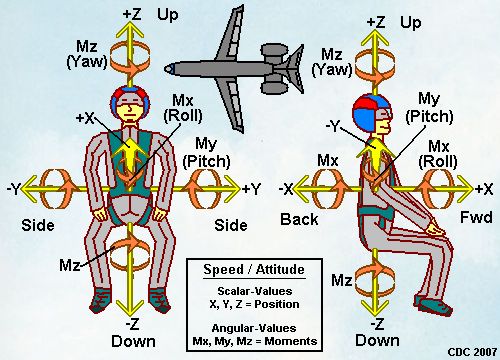
Above is an illustration showing the so called "Six-Degrees Of Freedom" a person or vehicle (such as a pilot in an aircraft, or person riding a roller coaster) experienced in three-dimensional space. Ofcourse, we have three axes, one for each "dimension" denoted by X (forward and backwards), Y (side to side), and Z (up and down). The values, such as +Z and -Z denote the scalar directions along each axis (such as +Z for "up" and -Z for "down"). These three scalar axes are called the "position" or "speed" axes and represent linear motion. Around each of the three given axes, there are additonal "moments" around each, which is ANGULAR speeds (or rotation) about that axis. A moment around the Z (vertical) axis is called a YAW, a moment around the Y (side) axis is a PITCH, and the moment about the X ("heartline") axis is a ROLL. The three position axes, and the angular moments around each of them, consitute the "six degrees of freedom". A person driving a car most often deals with a mere three of the six "degrees of freedom", usually velocities along the X and Y axes, and yaw (turns) along the Z moment. An aircraft, roller-coaster, or skydiver on the other hand, deals with all of the six "degrees of freedom".
Based on the diagram above, an ACCELERATION can also occur along any of the axes and / or moments of each. For example, a car going forward from rest is got an acceleration in the +X direction. If the car turns, or yaws, is has a MOMENT about the Z axis (vertical) as well. The RESISTANCE to acceleration, due to INERTIA, causes an apparent force to an observer in the OPPOSITE direction of the axis (or moment) involved. For the same example with a car starting from rest, a passenger experiences a force pulling you BACK into the seat (-X, or Gx-) as the car is accelerating forward (+X). If the car makes a yaw (or turn) to the left, a force pulls the passenger opposite due to intertia, which will push him or her to the right side of the vehicle. In the next section, you will see a great focus on the Gz forces (such as accelerating upward (along the +Z axis, with a strong opposite reaction force "pulling you down" or Gz+). For simplicity, the acceleration along the axis (or moment) determines the apparent G-Force value of positive (or negative).
G-Forces can affect a mass in any given direction, called a VECTOR. The most common issues with such forces addressed here are the effects on the average human and acting on that person sitting in an upright position (which is the Z axis) and is commonly referred to as "Gz". A person riding a roller coaster and fighter jet pilot will all eventually feel the effects of Gz.
As mentioned earlier in the section above, the roller coasters actually have a rating in "how many G's" they produce! As a coaster car, and its riders, turn abruptly as in a steep banked turn or "pull up" (bottoming out in a dip after a hill), they will feel the effects of Gz, often in the 3 to 4 G-unit range. That means if you weigh in at 200 pounds, your LOAD FACTOR (weight in the higher Gz environment) will be 600 to 800 pounds for 3 and 4 G units, respectively. In comparison, I have flown high-performance aerobatic aircraft into steep banked turns (or pulls out of a dive) and endured in excess of 9 G-units. Weighing 150 pounds at the time, my RELATIVE weight (load factor) was at least 1,350 pounds!
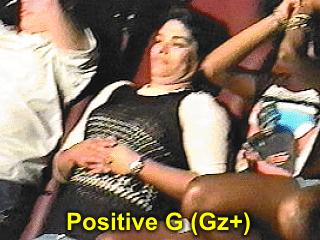
The effects of G-Forces are not only high load factors and "your body weighing as much as a car" as weight increases. A much more serious and dangerous problem arises in high-G environments. G-forces can push you down into the seat or pull you upwards from it too, depending on the meneuver. We will call the "pushing-down" a POSITIVE G (or Gz+) and the "pushing-over" a NEGATIVE G (or Gz-). Negative G's (or Gz-) will pull a person out of the seat and cause them to strain against the harness or restraint (hopefully one was provided for that). Gz- is more common in aerobatic aircraft, such as when flying upside down, where -1 G will be experienced. You can have high negative Gz- values too, such as -3G. The average human can tolerate about 7 positive G's but only about 2.5 negative G's without special equipment. Note the effects of about +4.5 G (actually an "eyeballs-in" Gx+) on the woman in the center of the picture above.
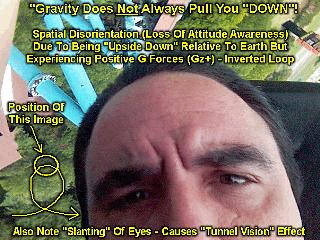
G-Force, as described herein, is a FORCE that "mimics" gravity. It is a result of some force other than gravity, such as centrifugal force and / or acceleration that acts on a subject from a certain direction. Since this force can be in ANY direction, it can also be AWAY from the relative (or intuitive) pull of gravity of earth! This can cause serious disorientation in pilots in air combat simply because the apparent "gravity" he or she experiences is not necessarily where the "real" direction of the ground is. In addition to positive or negative Gz (up and down), there are also positive and negative variants of Gx (front to back) and Gy (side to side) movements. In the annotated picture above, I am being "squashed" into a roller coaster seat by at least 3 or 4 positive Gz units, however, notice where the ground is ... Above me! This is because of the attitude (orientation in three dimensional space) of the craft I am traveling in, which is executing an inverted loop. Centrifugal force from the turn at high speed is far more than the acceleration of earth gravity, and is in the opposite direction. Normally this will induce a negative Gz, but since I am inverted, I experience positive Gz (pulls me down into the seat). In a roller coaster this is not dangerous, but imagine if I was flying an airplane, and doing the same meneuver. If I lost reference to the ground, there would be no way to "find it" since relying on "gravity" in that case would be useless! Loss of spatial (attitude) awareness has caused many fatal airplane crashes, one where the pilot confused the stars with runway lights! The stresses of the Gz forces also cause "slanted eyes" from squinting or grunting, and can cause a "tunnel vision" effect in addition to a grey out or blackout.
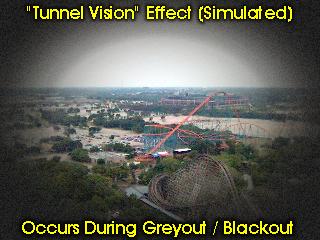
The picture above is a simulation of what "tunnel vision" looks like to a person experiencing a grey-out (or just before blacking out). Squinting can also cause tunnel vision because of "slanting" of the eyes. The effect here is high positive Gz induced, and starts with a narrowing of the peripheral vision. Spots or flashing lights, a type of hallicination known as PHOSPHENE begins in the darkened peripheral areas of the vision field. The simulated image above is called a "grey-out" (note loss of color, especially near the edge of the periphery). If high Gz+ conditions are sustained more, the phosphene and dark regions close to where the entire field of vision is lost. This is called a "black-out". If the high Gz+ forces are still not removed, loss of consciousness can occur, which is called a "G-LOC". When high NEGATIVE (Gz-) forces are pulled, squinting and "tunnel vision" still occur, and a similar "red-out" condition may be experienced, and is explained below in the section for negative G's.
Most amusement park rides rarely exceed 4 or 5 G-units, unless the G load is for a brief period of time. This is because there is liability issues with the park operators. When high positive G-Forces are experienced by the average human, a tremendous amount of stress is placed on the persons cardiovascular system. After a few seconds at about 7 G's, this is enough to cause blood and bodily fluids to flow away from the head. The temporary loss of blood (and therefore oxygen) first causes loss of vision (tunnel vision, then grey-out) then progresses to loss of vision (black-out) and eventually loss of consciousness (G-Induced Loss Of Consciousness, or G-LOC).
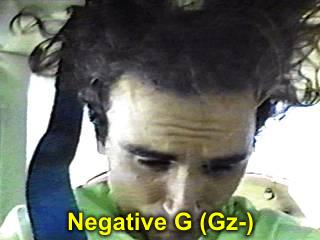
Negative G-Forces present yet another dangerous effect, where blood is forced UPWARDS into the head and brain. This can rupture blood vessels the eyes in as little as -2.5 G's (called a red-out because of the squinting blood-shot effect on the eyes). 6 Positive G's can be tolerated while -6 G's can be fatal (Hemorrhagic stroke, aneurysm, etc). Fighter pilots often use an inflatable suit (using compressed air from the aircraft) to force the blood back into the upper parts of the pilot's during high positive G meneuvers. Other aircraft systems feature reclining seats to lessen the Gz effects on the body (by "trading" off to more of a Gx force). With this concept, up to 20 G's can be endured if lying down (along X axis, such as "eyeballs in") for a fit person! Below is a picture of myself in about -1 G. Can you see the "upward pulling" effects (hint - long hair falling UP)?
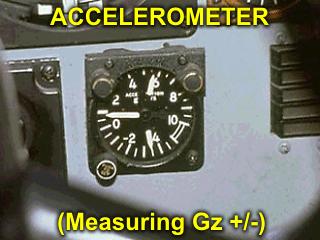
Devices exist to measure the acceleration, especially along the Z (vertical) axis as in the Gz cases described here. They are common in nearly all aerobatic aircraft and are called ACCELEROMETERS. The picture below, courtesy of the US Air Force, shows such a device. The analog (movement) display shows how many positive and negative G's were encountered since it was last reset via two needles on the dial. One needle (higher one) shows about 6 positive G-units while another (lower needle) shows -3.5 G's (pretty extreme). The left needle is the current G load at the time the picture was taken, and is near normal earth gravity (about 1 G-unit). The button in the lower-left of the dial resets the two "trend" needles to 1 G-unit.
To make clear the effects of such accelerations, relative to gravity, a table has been provided below to show how G-Forces will affect an average adult male who weighs 150 pounds and is sitting in an upright posture and in a harness to accomodate negative G-Forces as well. All G loading will be assuming a Gz +/- (normal to the persons height in the seat). There are 4 columns, the first is the "G's" for the G-units, the second is the "LOAD", which is the 150 pound person's "weight" he may experience (load factor), the third is an example of such environments that type of G-Force might be experienced, and finally, the effects on the average man.
| G's | LOAD | EXAMPLES | EFFECTS-ON-AVERAGE-FIT-ADULT |
| 0 | 0 | Orbit, free-fall | No weight, floating - No force on body felt |
| .16 | 24 | Moons gravity (1/6 G) | Too light to walk, need to "hop", very light feeling |
| .5 | 75 | A bit more than Mars gravity | Easier mobility (half effort required), can jump higher, euphoria |
| 1 | 150 | Earth gravity | Normal weight On surface of Earth |
| 2 | 300 | Fast aircraft takeoff | "Leaded" feeling, difficult to pick up arms and legs |
| 3 | 450 | Space shuttle launch | Difficult mobility |
| 4 | 600 | Roller coaster sharp-turn | Immobility, tunnel-vision then grey-out if sustained |
| 7 | 1,050 | Pull-up in aerobatic aircraft | Immobility, black-out then loss of consciousness if sustained |
| 9 | 1,350 | Tight-turn in F16 fighter jet | Rapid loss of consciousness, possible internal injury if sustained |
| 12 | 1,800 | Parachute hard-opening shock | Immediate loss of consciousness, possible internal injury if sustained |
| 20 | 3,000 | Impact, rocket-sled testing | Internal injury, death if sustained |
| 46+ | 6,900+ | Highest human sustained (46.2g), rocket-sled (JP Staap) | Injury, death |
| 100+ | 15,000+ | Racing car crash | Severe injury, death |
| 214 | 32,100 | Highest survived by human (Kenny Bräck) racing car crash | Severe injuries (many internal), death |
| -1 | -150 | Upside-down, inverted flight | Upside-down feeling with own normal weight |
| -2 | -300 | Outside turn in aerobatic aircraft | Blood "rushes" to head, shoulders strain in harness |
| -3 | -450 | Outside loop in aerobatic aircraft | Painful with possible red-out (blood shot eyes) |
| -6 | -900 | Pull-out of dive inverted in aerobatic aircraft | Rupture of blood vessels in head (or brain - aneurysm) |
| -9 | -1,350 | Unusual attitude, upset of aircraft | Internal injury (mainly brain), stroke, or death possible |
Notes: The table above is more for SUSTAINED (or "lingering") G forces ... In that case, anything more than a second or two at or above 25g is usually fatal for most human beings. Brief accelerations of higher levels (known as a "jerk" in physics) can be tolerated (such as impacts). The direction of acceleration also is extremely important, such as the applied forces being along the Z-axis (up and down), versus laterally, such as X or Y, the latter being more tolerable for sustained forces. Also the negative G components along the Z axis can be extremely dangerous, with brain damage / stroke occurring in as little as one third or half of what the maximum positive component that can be tolerated. Sustained G forces over 10g (or "jerks" over 20g), especially along the Z axis, can also cause severe injuries, such as broken or sprained joints (particularly the neck or back), or even lethal internal injuries (such as a torn aorta). Also, something like a slap to the face can impart hundreds of G's locally without much damage. Aerobic (high impact / dancing) exercises also can impart 10 to 20 G's to the lower legs and feet.
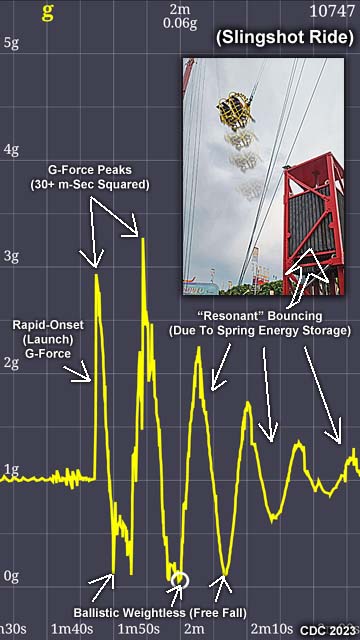
The image above was obtained by using an app (G-Force Logger) available for Android phone users (and was also used in the next 3 examples in this section). The example here was taken during a ride on the "Slingshot" ride at the Orange County Fair in S California in July 2023. The yellow plot is the G forces experienced while I was on the ride, with the app running and my phone secured in my pocket. The plot only measures absolute value G-Forces (negative G's show up as a positive value) and it's regardless of the direction (X, Y, or Z). From left to right, once strapped in, the ride begins with a release of a gondola holding its occupants. The energy required for the launch is stored in a unit with springs, and abruptly released, accelerating the occupants upward at roughly 30 meters-per-second per second (~3 G's in this case), reaching over 60 MPH (100 km/h) in about a second. The rapid jolt (or "jerk" as it's called in physics) can be seen, peaking near 3 G's, then near zero G as the gondola coasts upward and free falls back down in a ballistic (like a ball thrown upward and falling back down) path. Being a spring operated apparatus, the gondola and its occupants continue bouncing up and down, albeit lower each time, as energy (in the system) is dissipated (transferred to other means, such as heat in a "damped oscillatory motion" - Note the damped curve too!) as one proceeds from left to right on the graph.
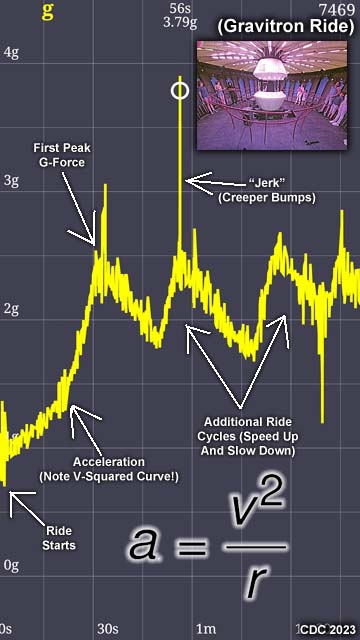
Using the same G-Force Logger app (running on my phone in my pocket), this example is from the "Gravitron" flat-ride (called "Alien Abduction" at the Orange County fair in July 2023, among many other re-branded names). This ride consists of a covered rotating turn-table, with the operator in the center of the ride, and sliding "creepers" on rollers on the sides where guests lay against. As the ride accelerates, centripetal force is experienced, peaking anywhere from 2.5 to 3 G's, and with the angle of the side wall and creepers, guests roll upward and remain in a "pinned" position. In the graph, the ride starts at the left, and accelerates to a steady RPM, reaching a tangential velocity from 50 to 60 MPH (or about 75 to 100 km/h). Note the prominent "parabolic" curve as the initial acceleration about the curve occurs, denoting the kinematic nature of centripetal acceleration, where the velocity is a squared value. Proceeding left to right, the ride rotates and speeds up / slows down a few times, causing the creepers to roll up and down with the component of the acceleration vector relative to the wall, which is at about a 60 degree "bank" angle (creepers should roll upwards as G forces exceed 2 G units). The spikes (or "Jerks" as they are called in physics) in the G force plot are from when the creepers jolt to a stop at the upper / lower limits of their roll during ride cycles.
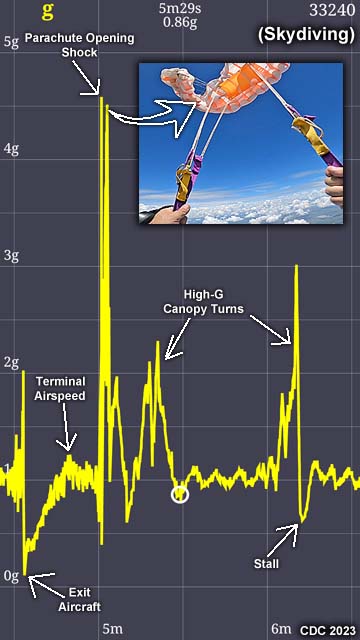
Finally, one last example, also using the G-Force Logger app (running on my phone in my jump-suit pocket), is a skydive from the exit point in the aircraft (a Cessna C-208 Caravan over Clewiston, Florida in July 2023), through deployment of my ram-air parachute, and subsequent canopy flight with maneuvers. From left to right, I exit the aircraft, and the near normal 1 G of earth gravity drops drastically as I enter free fall where the lift of the aircraft's wings no longer prevents me from falling. I reach a near zero G as I exit, with just the drag from the air affecting me. Rather quickly, I accelerate to terminal velocity, about 120 MPH (~190 km/h) indicated airspeed, and the G load returns to near 1 G - I am still falling fast, but not accelerating anymore (relative to the ground) as the force of the air drag is nearly equal to my weight. Then I open my parachute, presenting a large increase in drag and rapidly decelerate in the process, where a peak of at least 4.5 G's is incurred. As a parachute opens, there is a line-snatch and shock, which is a rapid-onset / "jerk" (physics), and is hopefully at a tolerated level (hard opening can exceed 10 G's, and cause severe injury, especially if the parachute is not properly packed). Going from left to right, with my ram-air canopy, I cause some additional G loads (spiraling / 3 G's) as I fly it after deployment.
HTML File "coasters.htm" - Developed By Chris Collura
To Return To The HOME Page Of This Site Click The "INDEX.HTM" Link Here!